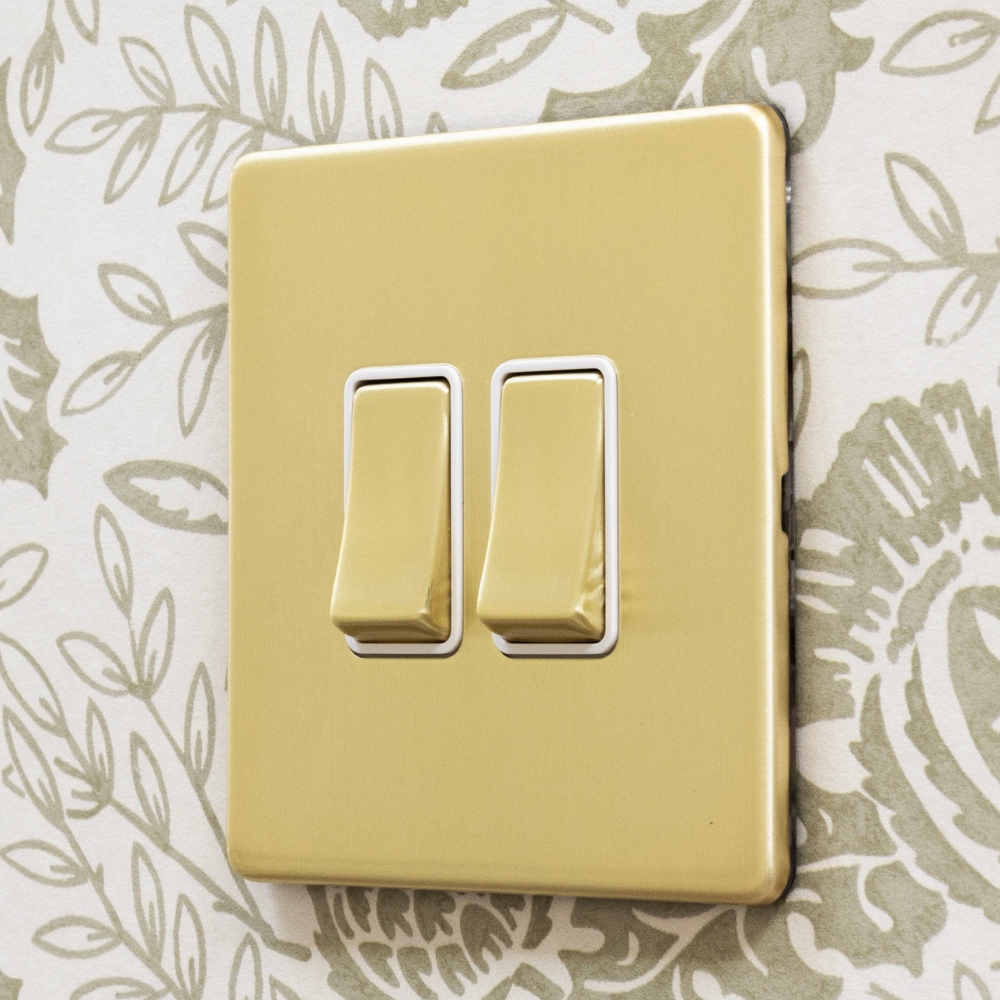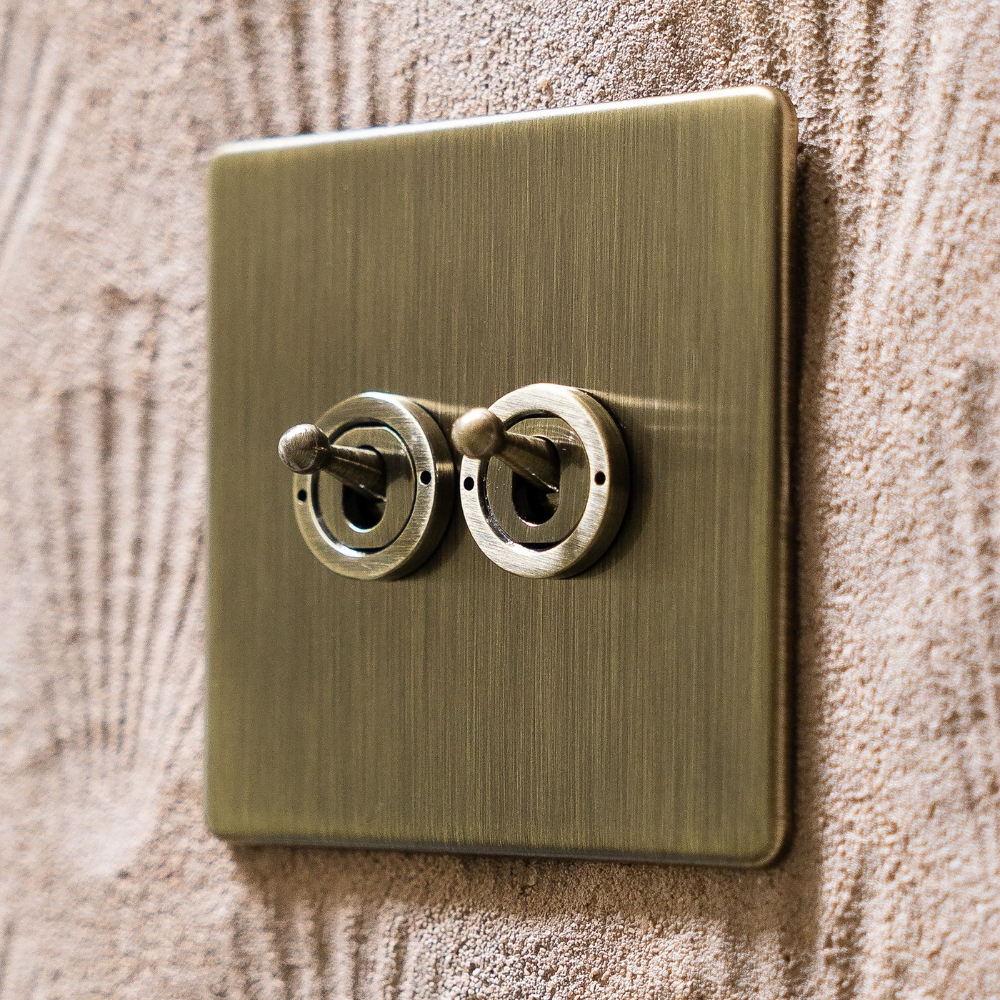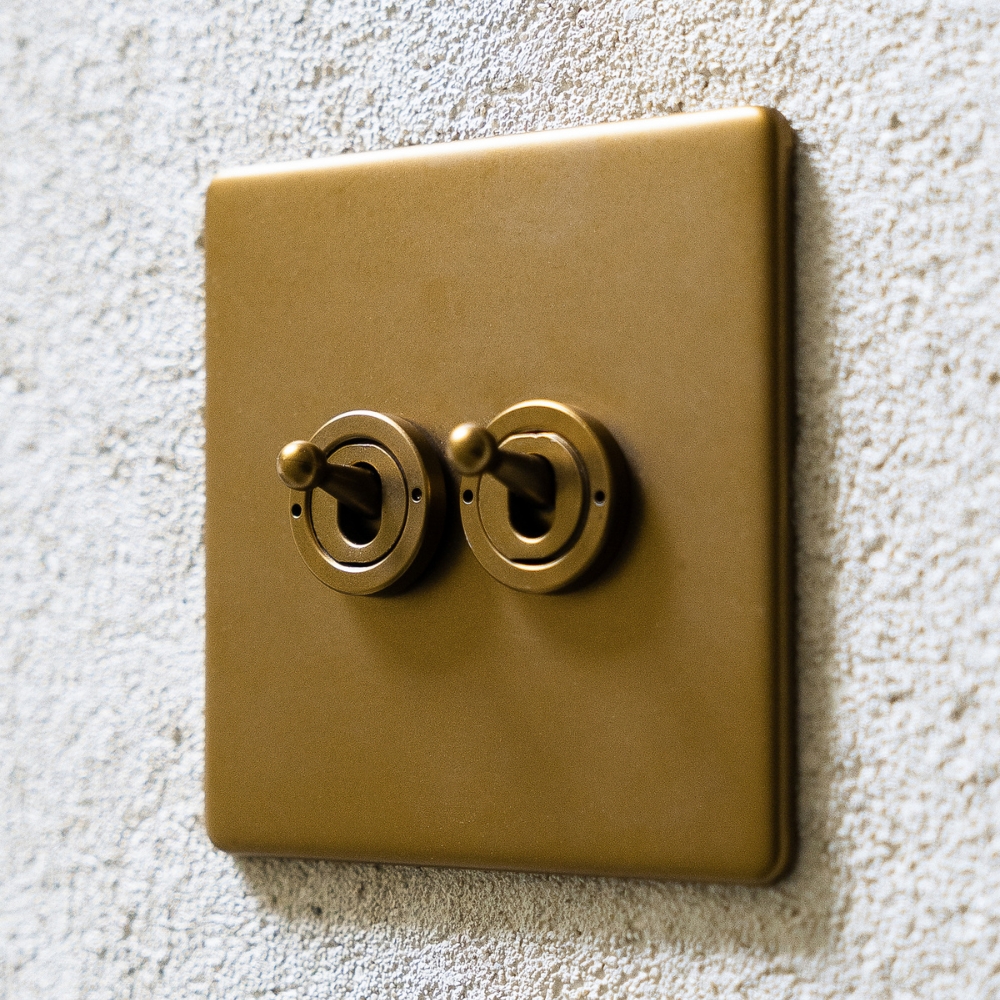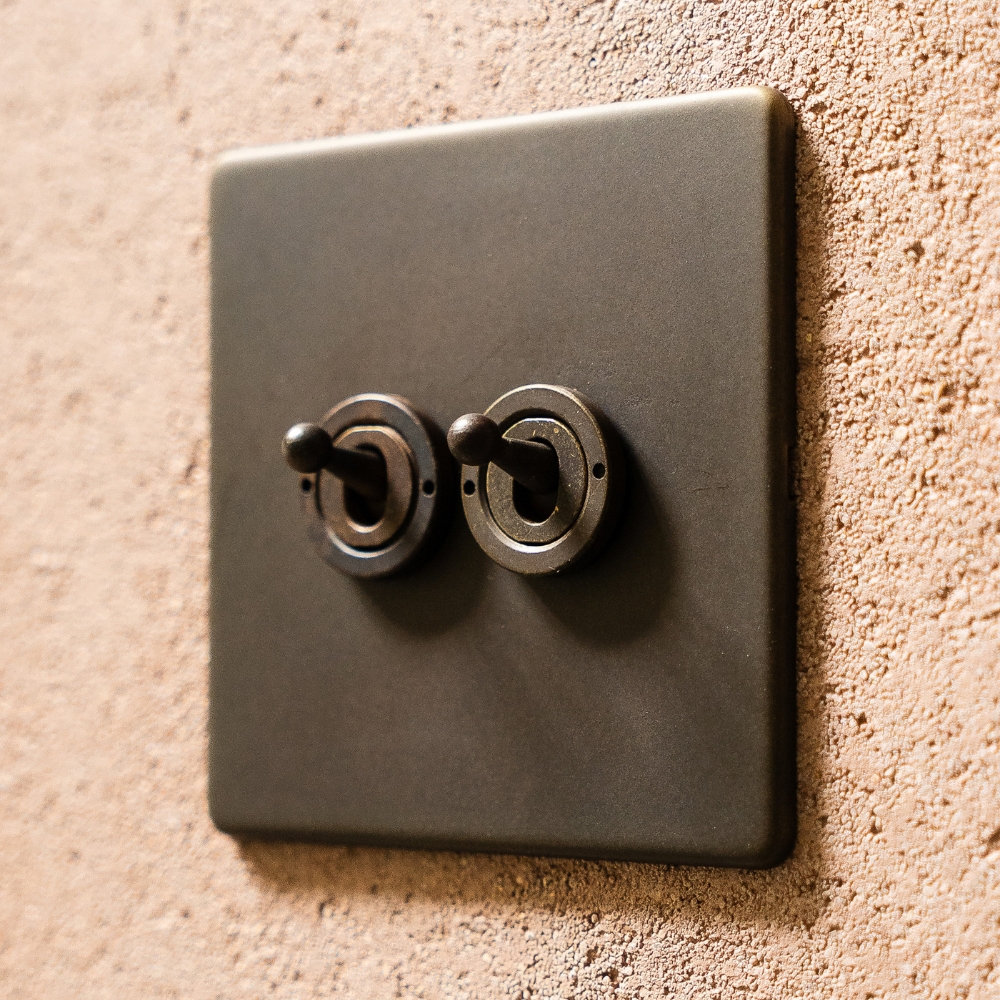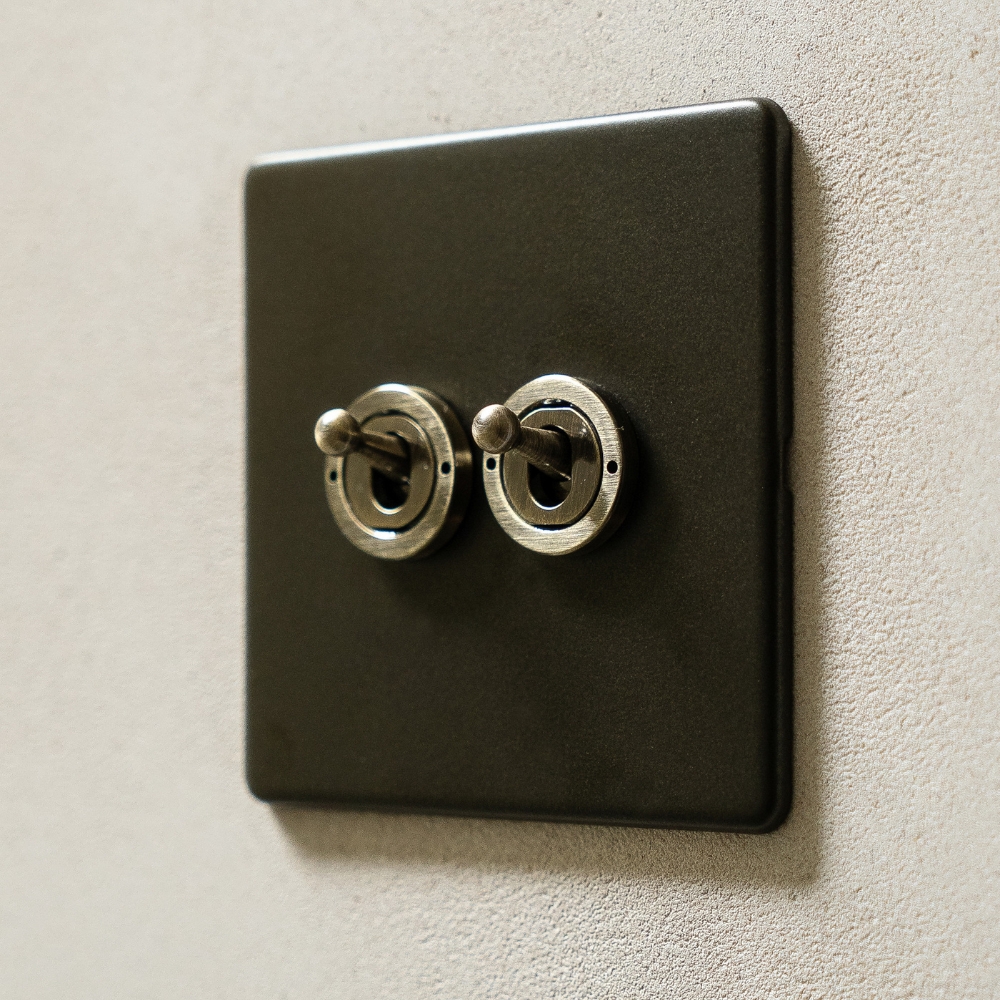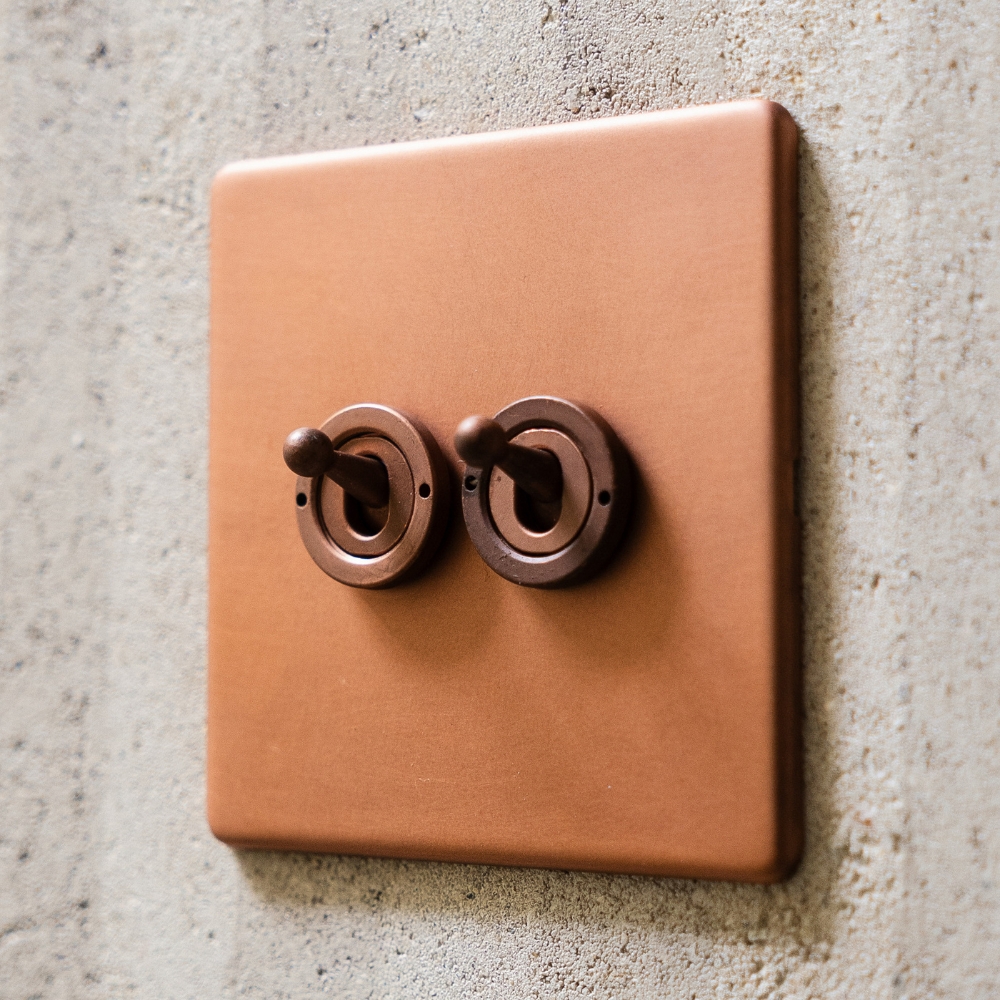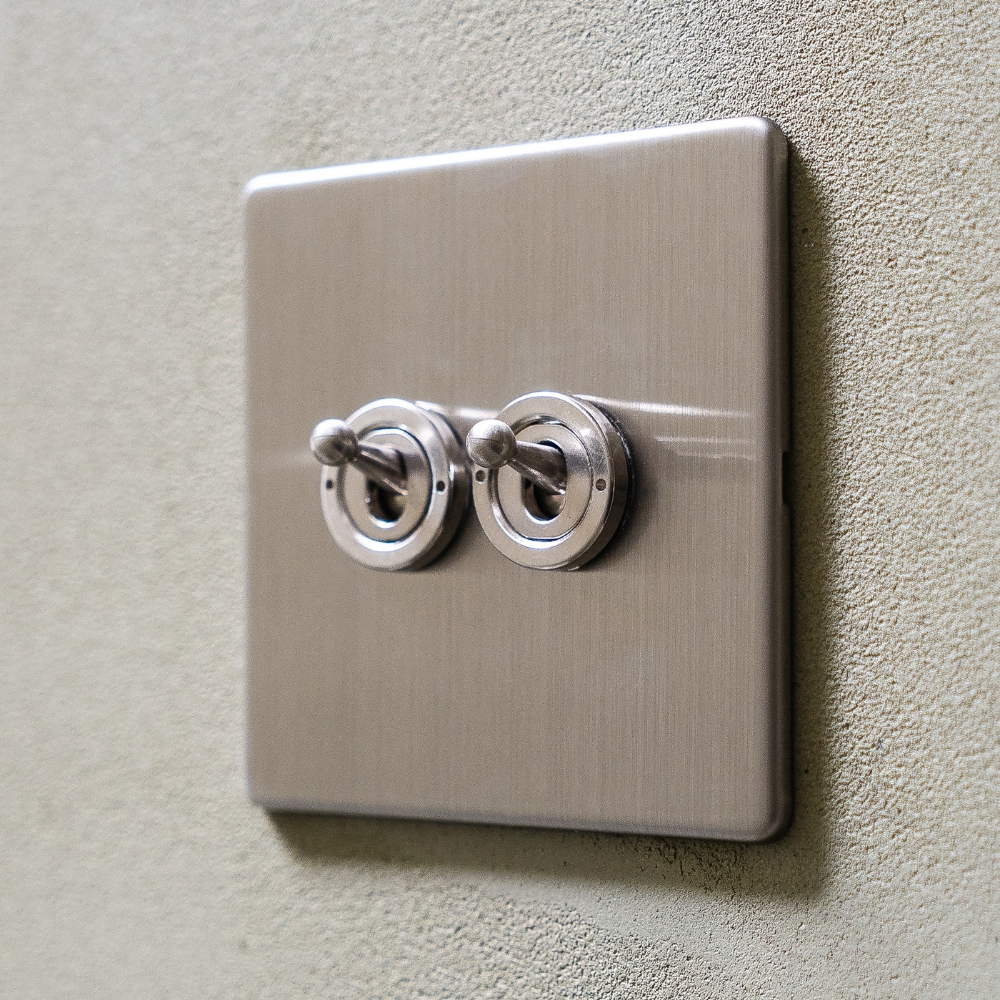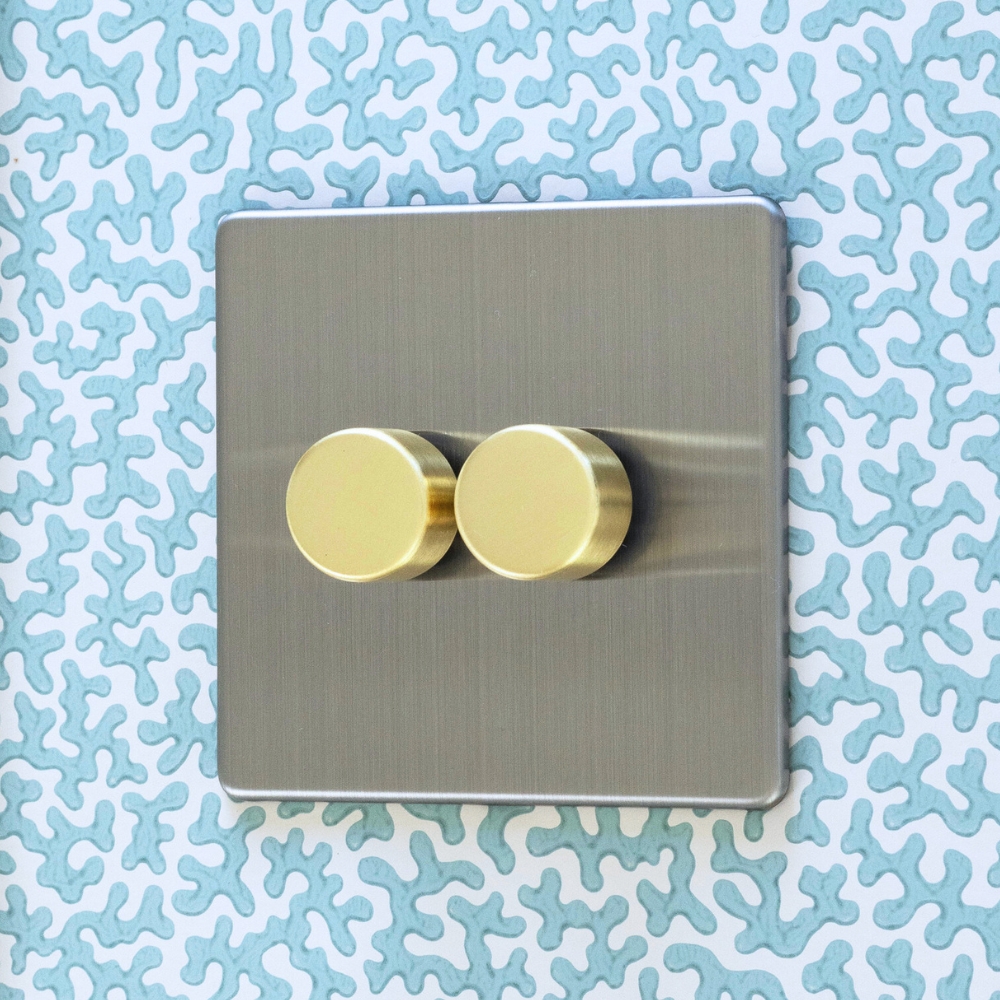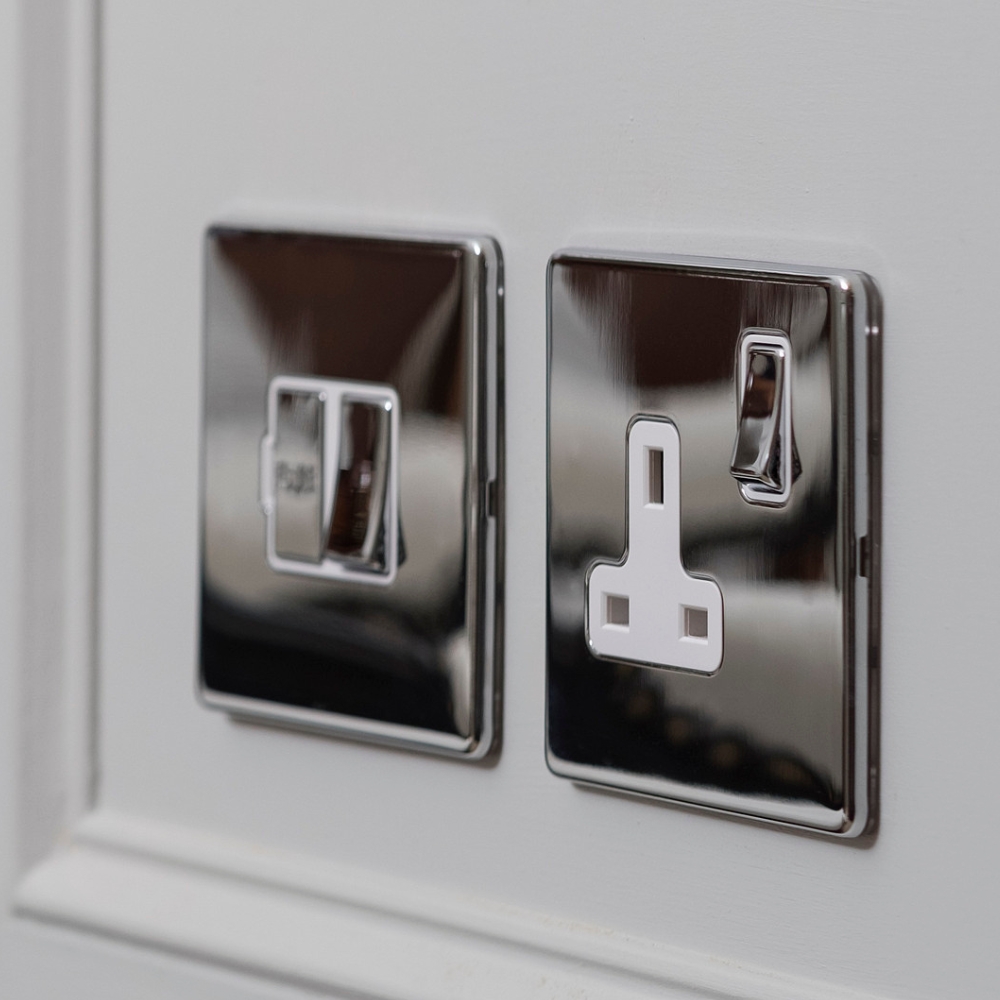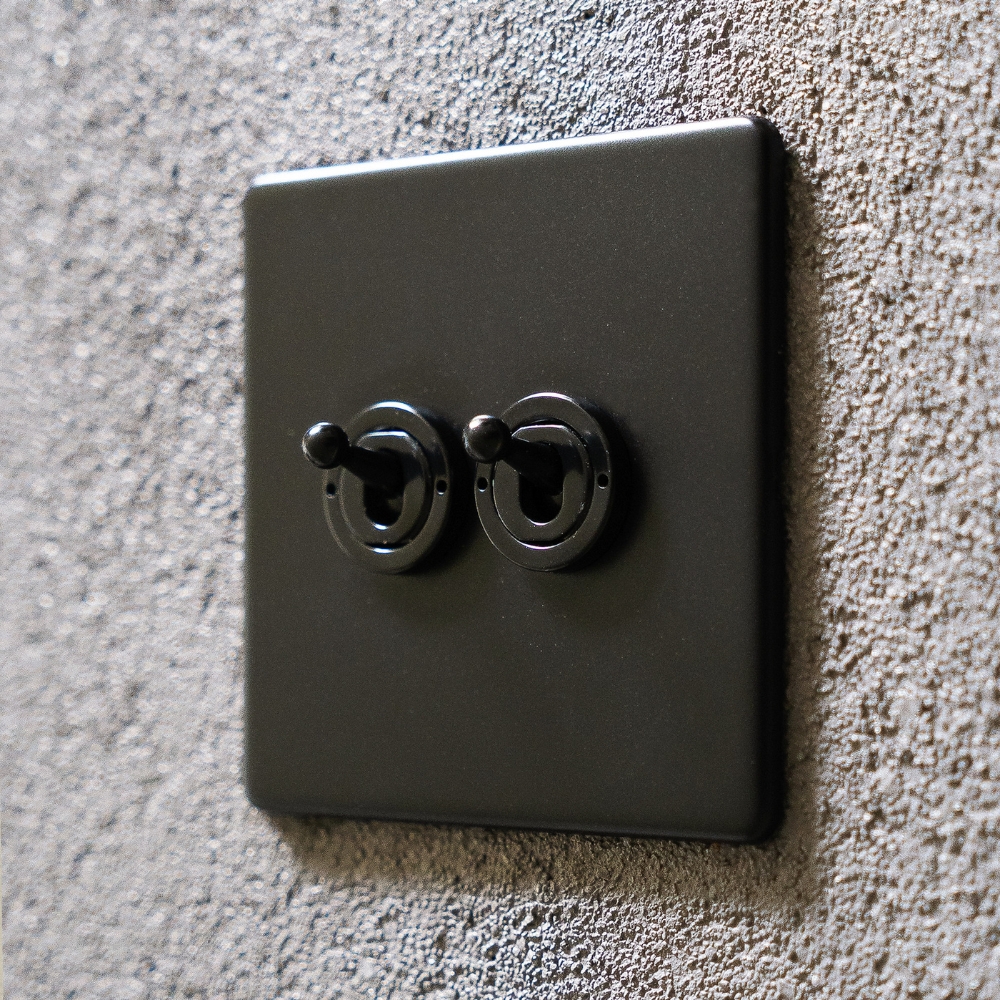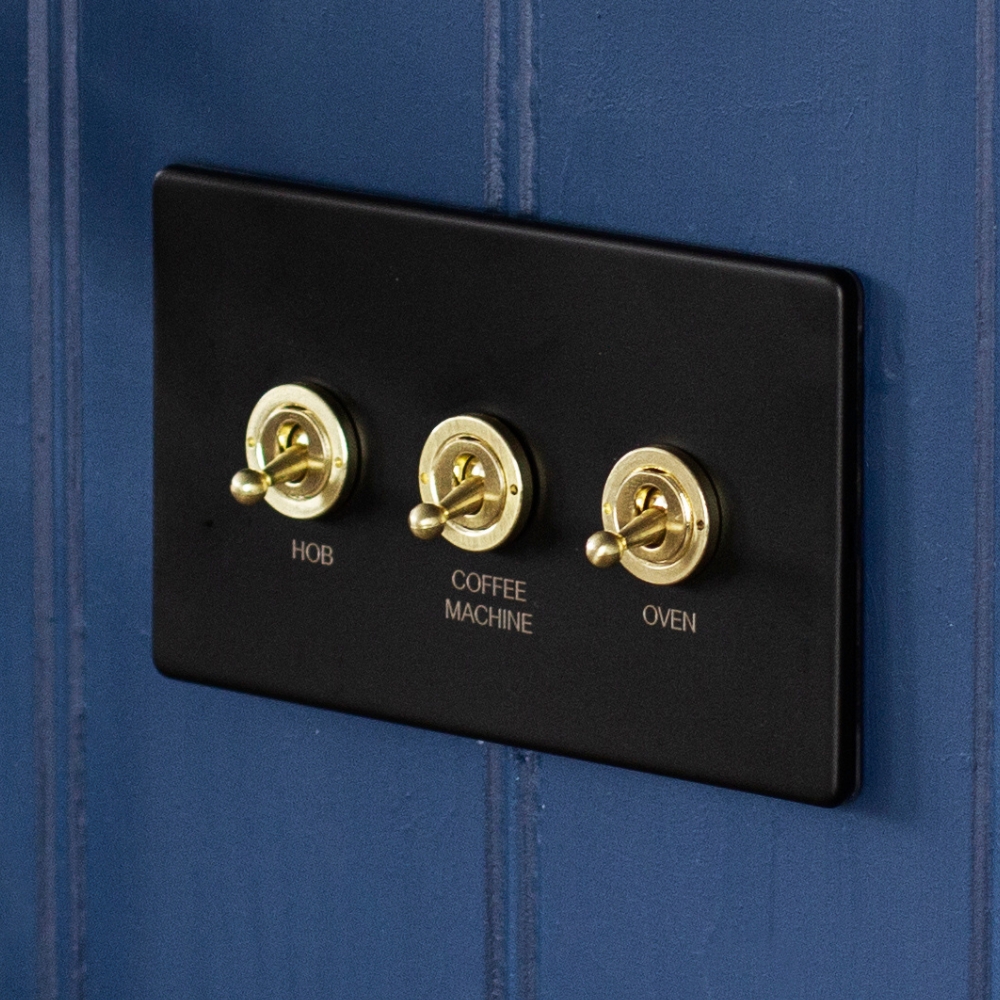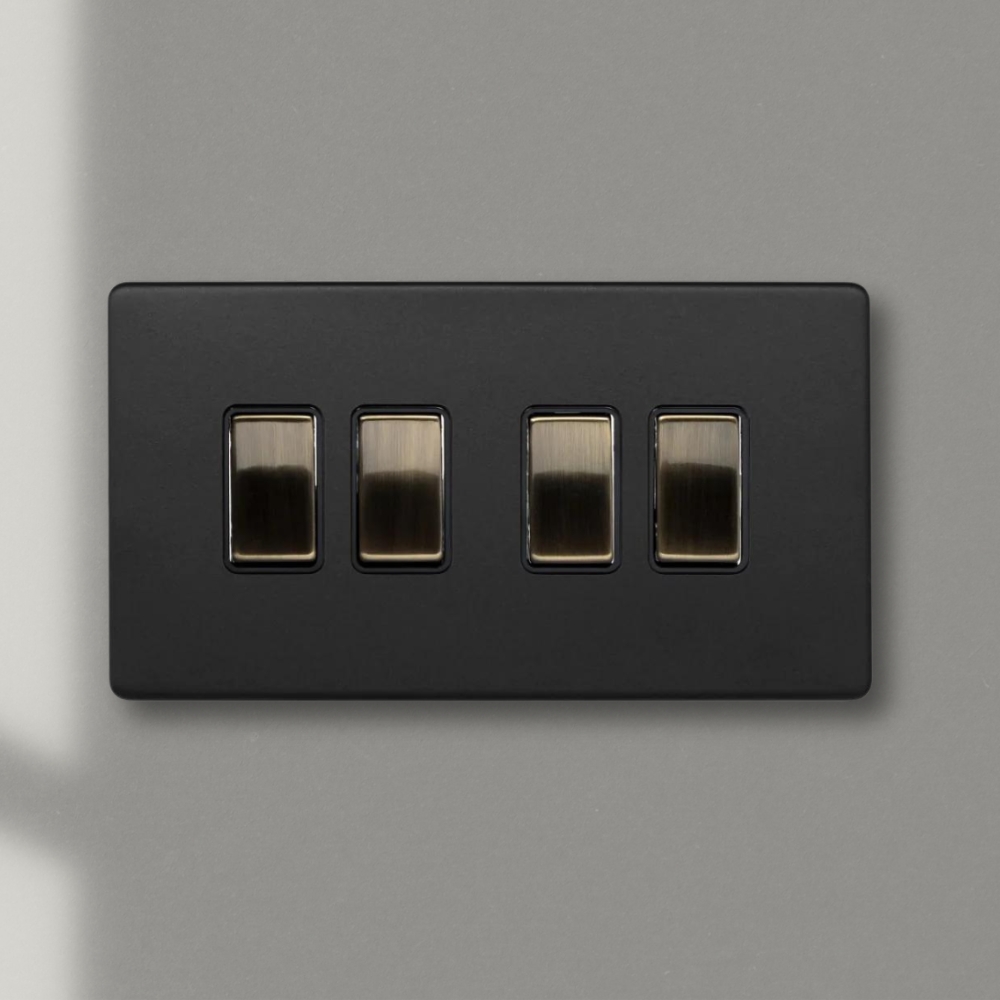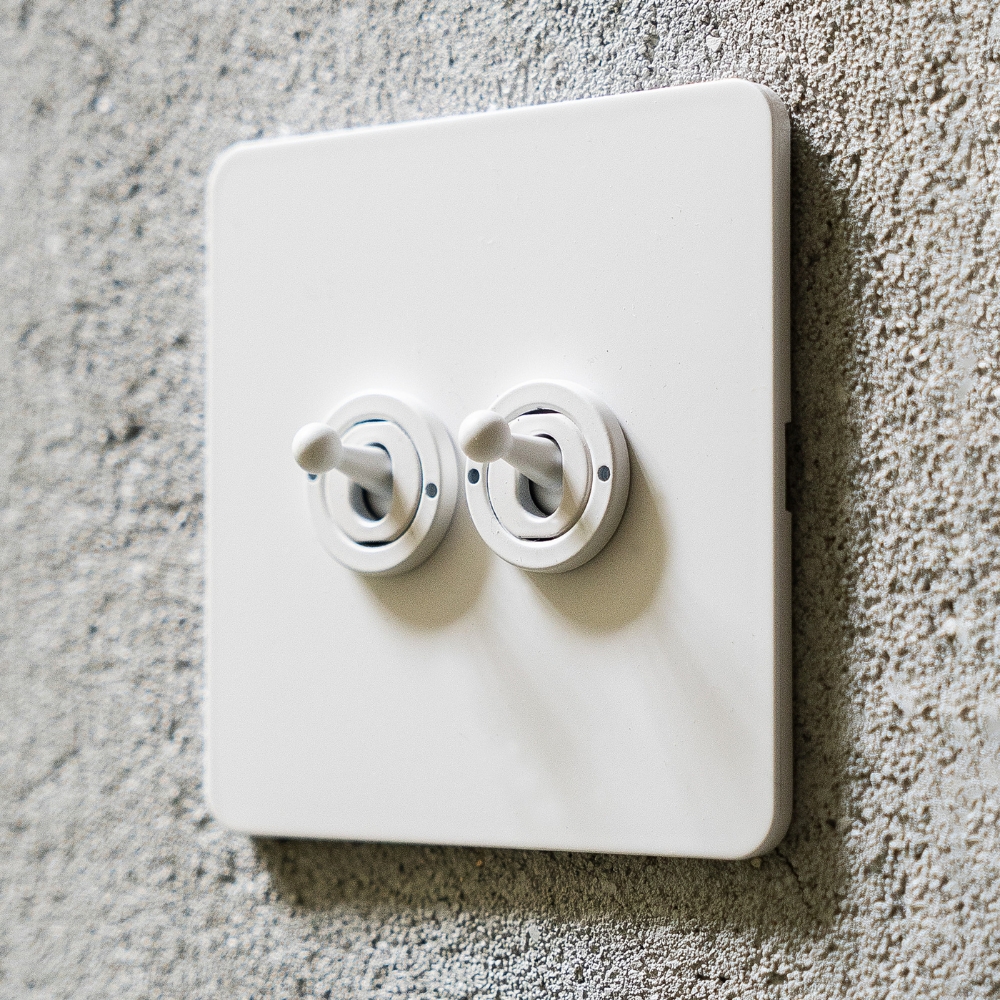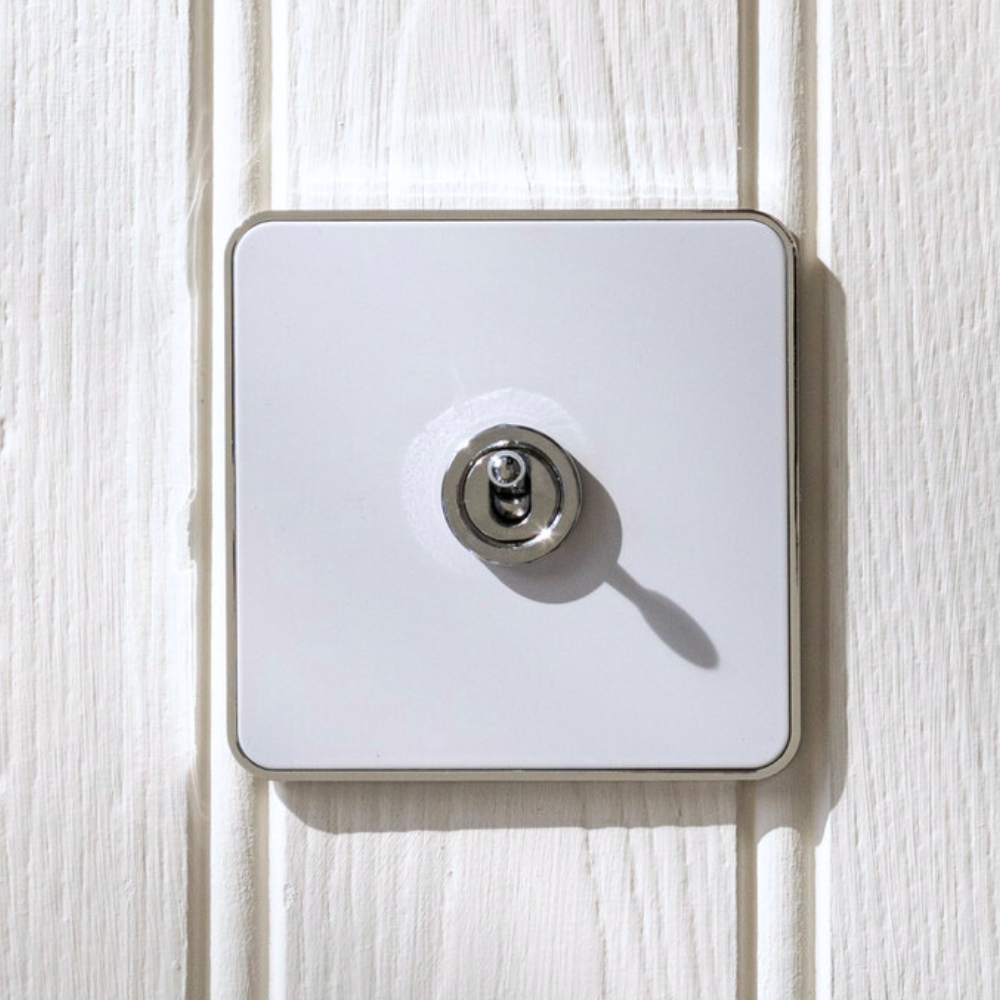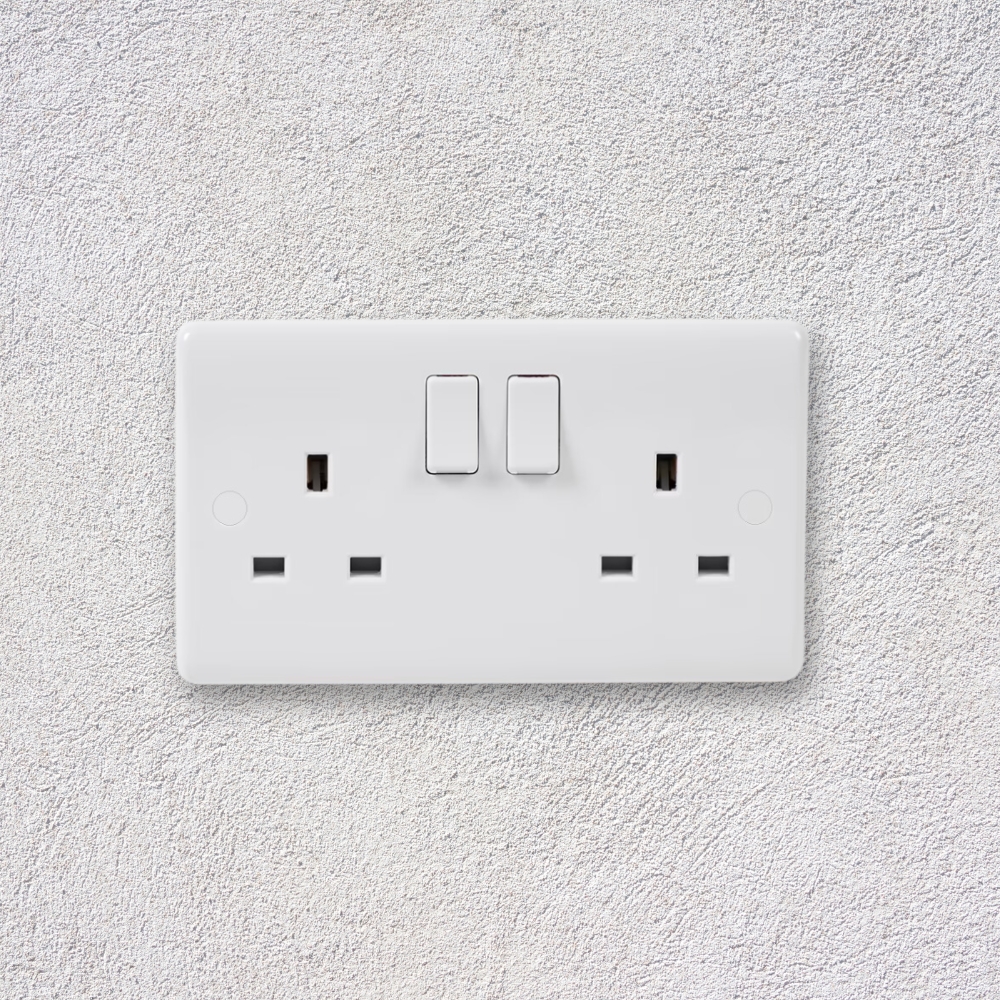When shopping for light switches and electrical circuits, two terms often come up: gangs and ways. For example, you may see a 1 gang, 2-way switch. It can be quite confusing to figure out what exactly this means. Understanding the differences between them can help when choosing the right setup for your home lighting.
Gangs
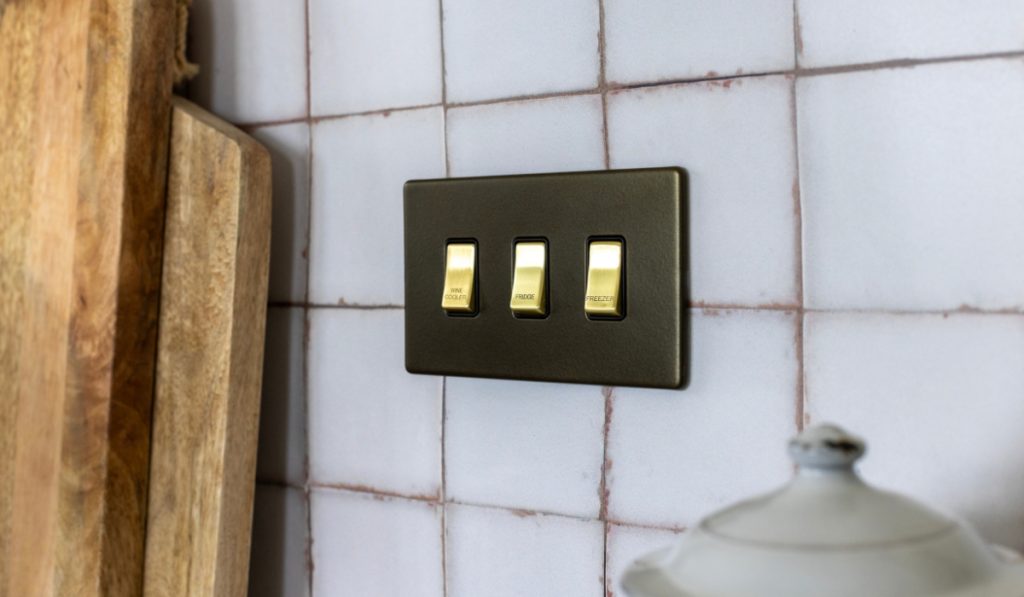
A 3 Gang switch on a Double Plate in Bronze and Brushed Brass
Gangs are the number of switches that are installed in a single location, side by side, within the same plate. A gang describes how many switches are grouped together in a single unit, with each controlling a different light or electrical fixture.
For example
- A 1 Gang switch setup controls one light or fixture.
- A 2 Gang switch setup has two separate switches, each controlling a different light or fixture. In a room with multiple light fixtures, a double-gang switch would allow you to control two separate lights from the same wall panel. This setup is common in rooms with overhead lighting and additional fixtures like ceiling fans or sconces.
- If needed, you can have a 3 Gang, 4 Gang, or 6 Gang on a double switch plate, depending on how many switches are needed.
Ways
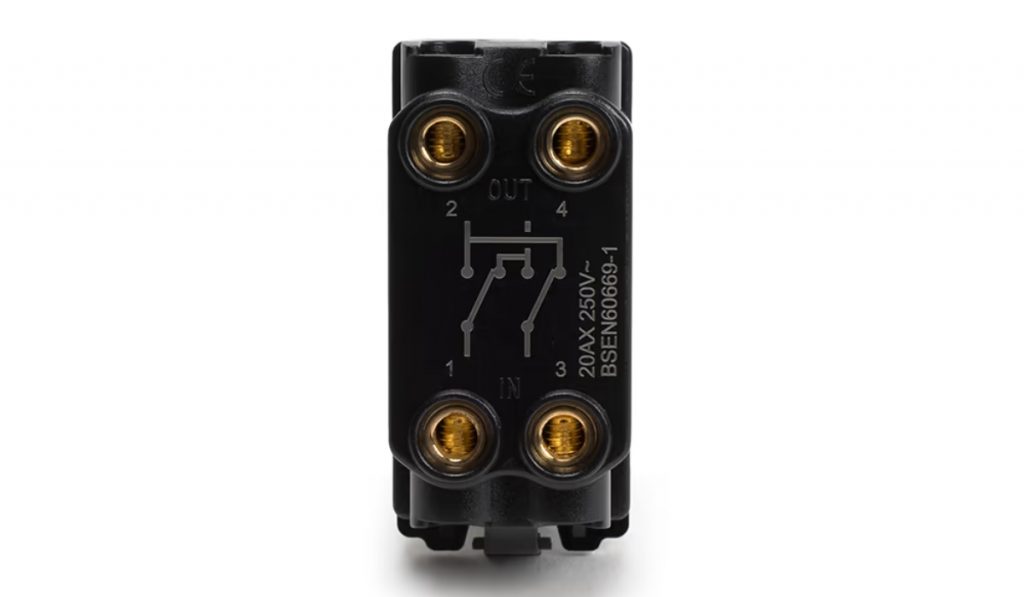
Rear view of an 3-way switch (Intermediate) Module
Ways refer to how many different locations can control the same light or fixture. A “way" describes the complexity of the circuit and the number of switches that can turn a single light on or off.
For example
- A 1-way switch controls a light from one location.
- A 2-way switch (common in stairways or hallways) allows the same light to be controlled from two different locations.
- A 3-way switch allows control of a light from three locations, and so on. This is commonly known as an Intermediate Switch.
In a large hallway, you might have a 2-way switch system with switches at both ends of the hall, so you can turn the light on when you enter and off when you exit. A more complex setup, like a 3-way switch, would allow you to control the same light from an additional location.
Key Differences:
“Gangs” refer to how many switches are grouped together in a single switch plate, each controlling a different light or device.
“Ways” refer to how many switches control a single light, allowing multiple points of control in a circuit.
Whether you're wiring a single light fixture or designing a more complex lighting system, we hope that this clears up the difference between gangs and ways, and helps you to choose the right switch setup for your home.
[related_products is_auto_added="1"]When shopping for light switches and electrical circuits, two terms often come up: gangs and ways. For example, you may see a 1 gang, 2-way switch. It can be quite confusing to figure out what exactly this means. Understanding the differences between them can help when choosing the right setup for your home lighting. Gangs […]
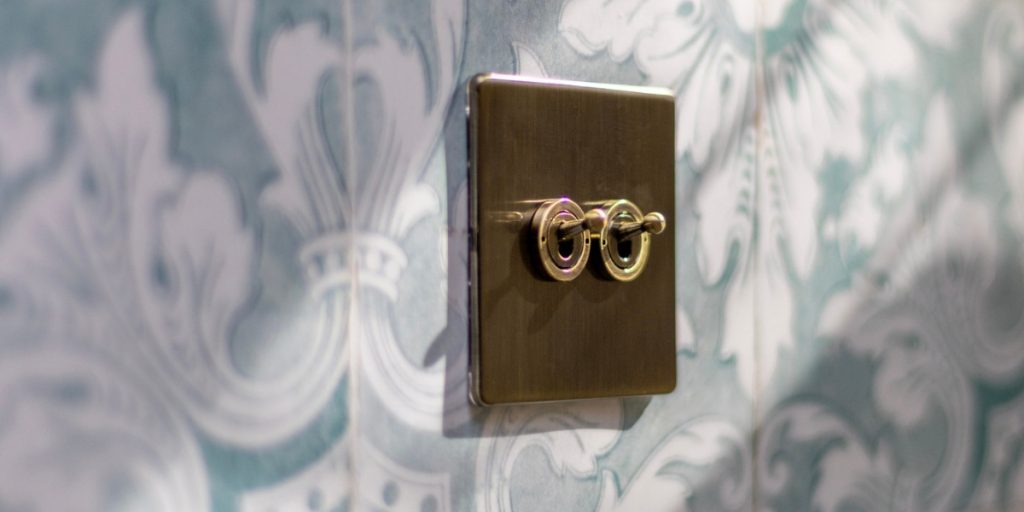
A momentary switch is a type of electrical switch that only stays in its "on" or active state while being pressed or activated. Once the user releases it, the switch returns to its original state, usually "off." These are usually in the form of retractive switches or push buttons. (If you would like to learn more about retractive switches, you can read our blog 'What Are Retractive Switches?'.
Momentary switches are common in many everyday devices. You likely encounter them frequently without even realizing it. Think of the buttons on a keyboard, a car horn, or a doorbell. Each of these activates a function only while you're pressing them, then stops as soon as you let go.
There are two main types of momentary switches:
Normally Open (NO) – The circuit is open (off) until the switch is pressed, completing the circuit, and allowing current to flow.
Normally Closed (NC) – The circuit is closed (on) by default, and pressing the switch breaks the circuit, stopping the current.
Momentary switches are ideal for tasks where brief activation is needed, providing simple, on-demand control. Whether it's for machines, tools, or simple gadgets, their functionality is versatile. This makes them indispensable in both consumer electronics and industrial equipment.
Here’s a list of common uses for momentary switches residential or commercial settings.
- Doorbells – Activates a chime while the button is pressed.
- Elevator Buttons – Calling a lift when the button is pressed.
- Intercom Systems or Tannoys - Momentary switches are used to activate the speaker or microphone.
- Security Entry Systems – These are typically used in situations where the door must be kept shut at all times, and entry requires a button press to unlock the door.
These are just a few examples, but momentary switches are widely used across a variety of industries and devices for brief and controlled interactions.
[related_products is_auto_added="1"]A momentary switch is a type of electrical switch that only stays in its “on” or active state while being pressed or activated. Once the user releases it, the switch returns to its original state, usually “off.” These are usually in the form of retractive switches or push buttons. (If you would like to learn […]
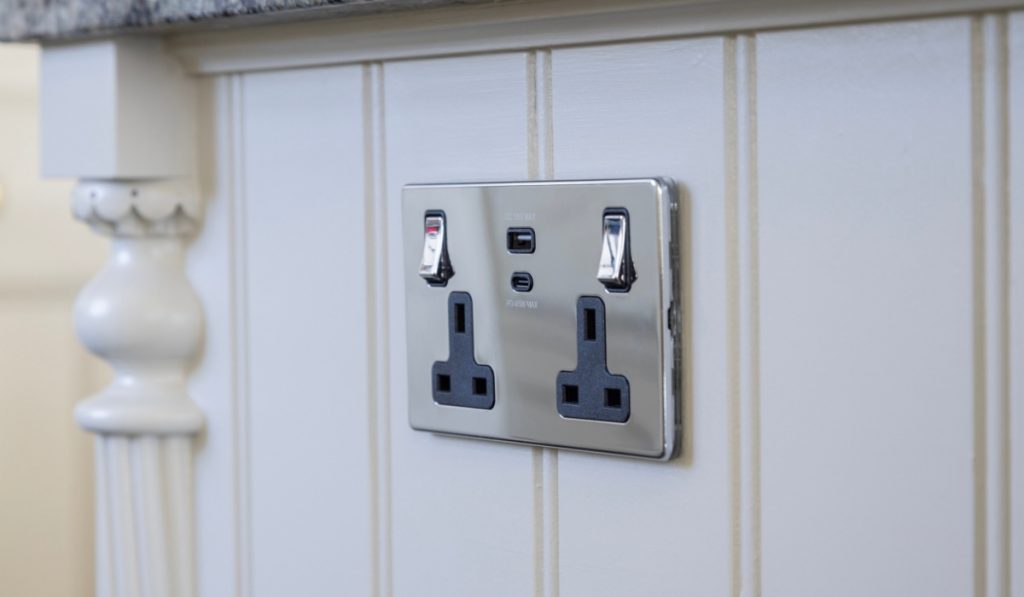
With the increasing demand for charging electronic devices, wall sockets with built-in USB ports have become a common feature in modern homes and offices. These sockets provide the convenience of charging your devices without needing a separate USB adapter. But did you know that there are different types of USB sockets? Let’s explore the various types of USB sockets you might encounter.
USB-A

The USB-A socket is the most common type of USB port found in sockets. It's the rectangular port that we’ve used for years in most of our devices. USB-A sockets are designed to work with standard USB cables, often used for charging smartphones, tablets, cameras, and many other devices. These sockets can vary in power output, 5V/1A for basic charging needs or 5V/2.1A or 5V/2.4A for faster charging of larger devices like tablets.
Though widely used, USB-A is gradually being replaced by more advanced ports like USB-C due to its limitations in speed and power delivery. Aside from being clunky, the USB-A can only be plugged in one way up.
USB-C

The USB-C socket is becoming the new standard for most modern devices, even Apple devices. Unlike USB-A, the USB-C connector is smaller, oval-shaped, and reversible, making it much more convenient since you can plug it in either way.
USB-C offers several advantages such as:
Higher Power Output: Many USB-C ports on wall sockets offer up to 18W and even 30W, making it ideal for fast charging smartphones, tablets, and even laptops.
Faster Data Transfer: While wall sockets typically focus on charging, USB-C ports can also support faster data transfer if connected to compatible devices.
USB-C sockets are becoming more common in modern wall outlets due to their versatility and ability to charge high-power devices.
Combination USB-A and USB-C
Some wall sockets come equipped with both USB-A and USB-C ports, providing versatility for households with different devices. These hybrid sockets allow users to charge older devices that still use USB-A cables while accommodating newer devices that require USB-C.
This combination is convenient, as you don’t have to worry about using different adapters. Each port usually has its dedicated power output, allowing you to charge multiple devices simultaneously without sacrificing speed.
USB-A with Quick Charge
Some USB-A sockets are equipped with Quick Charge technology, a feature developed by Qualcomm. These sockets can provide faster charging to devices that support the Quick Charge standard, for instance, many Android smartphones support this type of charging.
Quick Charge-enabled USB-A sockets can deliver 18W or more, allowing for significantly faster charging times compared to standard USB-A sockets.
Power Delivery (PD) USB-C
A step above standard USB-C, Power Delivery (PD) USB-C sockets offer even higher power outputs—up to 100W in some cases, for super fast charging. These are ideal for charging larger devices like laptops, tablets, and even power tools that require more power than a standard USB socket can deliver.
Power Delivery ports intelligently communicate with the connected device to provide the optimal charging speed, ensuring fast, but most importantly, safe charging.
The types of USB sockets available on wall outlets have evolved to meet the growing demands for faster and more efficient charging. Whether you're looking for a basic USB-A port or a more advanced USB-C Power Delivery option, understanding the differences between these sockets will help you choose the right outlet for your needs. As technology continues to evolve, USB-C, particularly with Power Delivery, is likely to become the dominant standard, offering a future-proof solution for charging a wide range of devices. You can find these super-fast charging sockets here at Elesi, and we hope this guide helps you to choose your next USB charging sockets.
[related_products is_auto_added="1"]With the increasing demand for charging electronic devices, wall sockets with built-in USB ports have become a common feature in modern homes and offices. These sockets provide the convenience of charging your devices without needing a separate USB adapter. But did you know that there are different types of USB sockets? Let’s explore the various […]
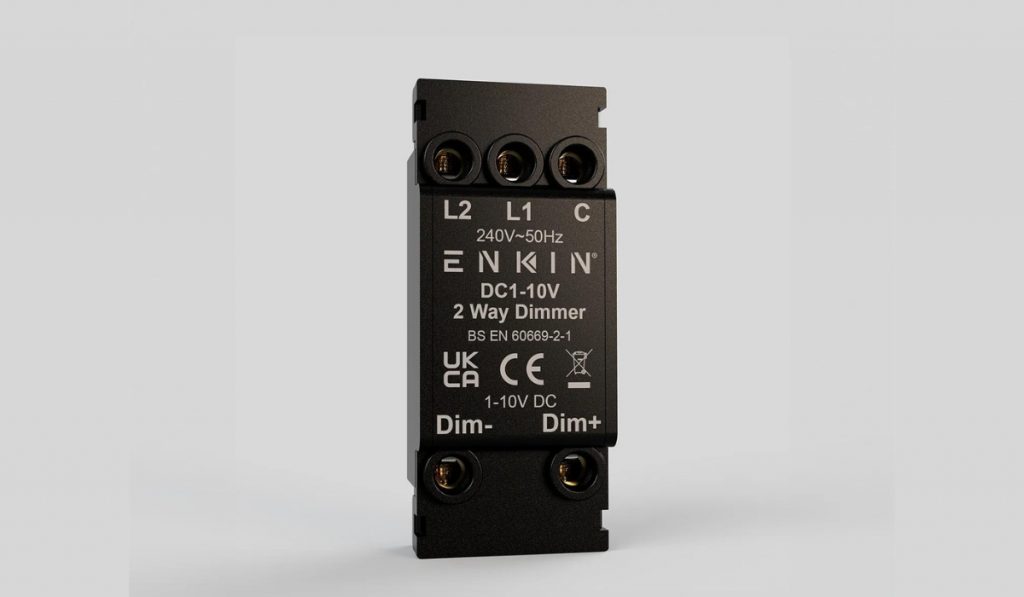
As energy efficiency and lighting control systems have become increasingly essential in modern buildings, the 0-10V dimmer has emerged as one of the most popular solutions for precise and customizable lighting control. Whether you're managing a residential, commercial, or industrial lighting system, a 0-10V dimmer offers reliable and simple control over light output. But what exactly is a 0-10V dimmer, and how does it work? Let’s take a closer look at the functions, benefits, and applications of this versatile technology.
What is a 0-10V Dimmer?
A 0-10V dimmer is a control system used to regulate the intensity of light emitted from compatible lighting fixtures, such as LEDs and fluorescent lights. It operates on a low-voltage control signal ranging from 0 to 10 volts DC and must be used in conjunction with a DC driver. The basic principle is straightforward: the voltage level dictates the brightness of the light. At 10V, the fixture provides 100% light output, while at 0V, the light is either at its minimum dim level or completely off, depending on the setup.
Core Functions of a 0-10V Dimmer
Smooth Dimming Control
The most crucial function of a 0-10V dimmer is its ability to provide smooth and continuous dimming. By adjusting the voltage signal, users can control the brightness level with precision. For example, a 5V signal would produce 50% of the light’s output, while a 1V signal may only output 10% of the light's full brightness.
This level of granular control makes 0-10V dimmers ideal for environments where adjustable lighting is essential, such as offices, retail spaces, galleries, and homes. Smooth dimming also helps in creating ambiance and reducing energy consumption.
Energy Efficiency
Another key function of a 0-10V dimmer is its role in energy savings. Lighting is one of the biggest contributors to energy costs, particularly in commercial or industrial settings. By allowing lights to operate at lower intensity when full brightness isn’t needed, a 0-10V dimmer reduces overall power consumption. This translates to lower electricity bills and a more sustainable lighting solution.
Many lighting systems with 0-10V dimming capability can also be paired with daylight harvesting sensors, which further improve efficiency by adjusting lighting based on the amount of natural light available in a space.
Versatility and Compatibility
The 0-10V dimming protocol is widely accepted in the lighting industry, which means it’s compatible with a broad range of lighting fixtures, including LEDs, fluorescent lamps, and even some types of HID (high-intensity discharge) lights. This versatility is one of the reasons why 0-10V dimmers are so prevalent in both new construction and retrofit projects.
In addition to its compatibility with a wide range of lighting technologies, 0-10V dimmers can be integrated into larger building automation systems or used as standalone controls. This flexibility makes them ideal for spaces with changing needs, such as multi-use commercial buildings, educational institutions, and warehouses.
A 0-10V dimmer is a highly functional and versatile lighting control system that can significantly enhance the energy efficiency, comfort, and aesthetics of any space. Whether used in homes, offices, or industrial environments, the smooth dimming control, energy-saving potential, and broad compatibility of 0-10V systems make them a popular choice for lighting solutions. With advances in automation and smart lighting integration, 0-10V dimmers will continue to be a go-to option for precise and customizable lighting control.
Understanding how a 0-10V dimmer works and the benefits it offers can help you make an informed decision when selecting a lighting control solution that meets your specific needs.
[related_products is_auto_added="1"]As energy efficiency and lighting control systems have become increasingly essential in modern buildings, the 0-10V dimmer has emerged as one of the most popular solutions for precise and customizable lighting control. Whether you’re managing a residential, commercial, or industrial lighting system, a 0-10V dimmer offers reliable and simple control over light output. But what […]

As the golden hues of autumn settle in, the design world embraces the warm, comforting, and sophisticated tones that define the season. This year, autumn interior design trends are all about blending comfort with modern elegance, drawing inspiration from nature in fresh, creative ways. Whether you’re looking to refresh your space or embark on a complete redesign, here are the top interior design trends for Autumn 2024.
Earthy Tones with a Twist
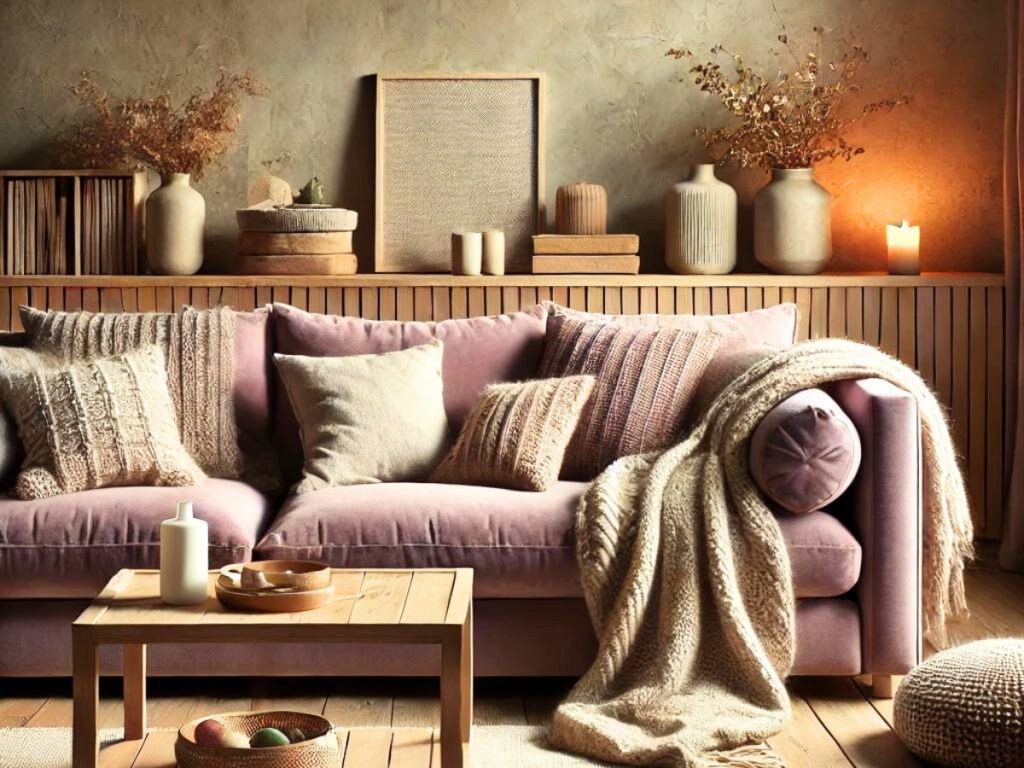
This year is bringing a modern interpretation to the traditional Autumn colour palette. Earthy tones like terracotta, warm browns, and ochre remain staples, but they’re being paired with unexpected accents like deep teal, olive green, and even hints of plum. These tones evoke the richness of nature while adding a bold edge.
Use sumptuous textiles in rich colours, such as knitted throws and cushions, alongside accent walls in earthy shades. A statement piece like a dark teal velvet sofa or plum accent chair can anchor the room and create a sophisticated yet warm ambience.
Layered Textures for Depth and Comfort
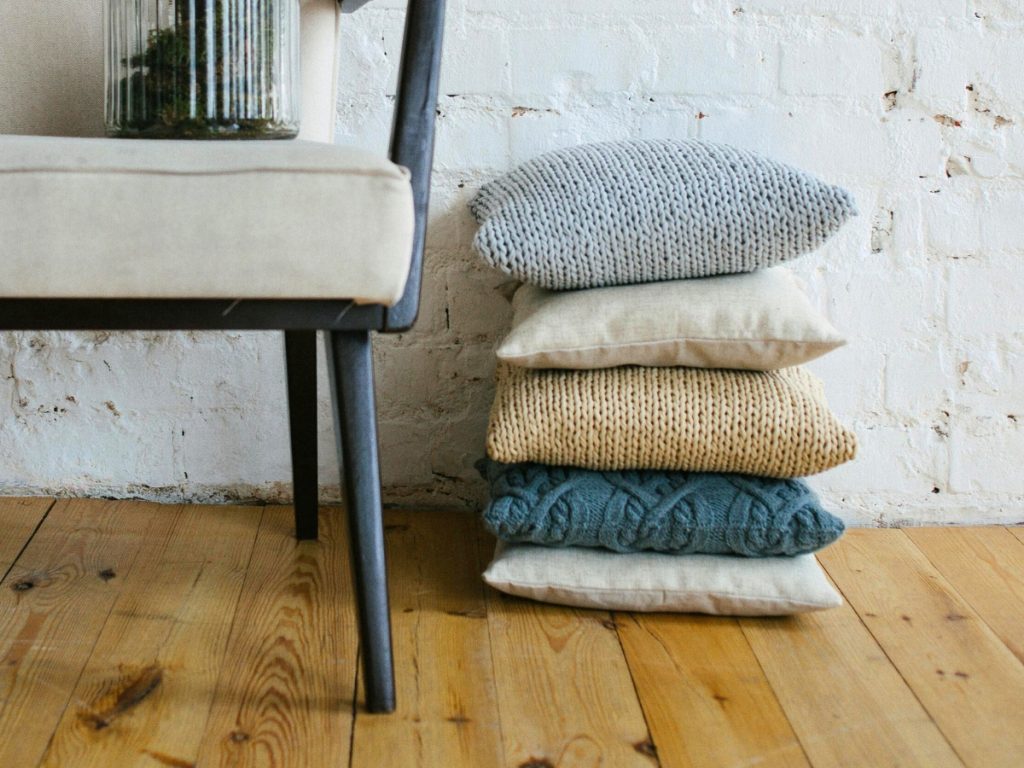
Texture is key this Autumn, as designers are moving away from minimalism towards a more layered, tactile approach. Think chunky knits, woven throws, rich velvets, and soft wool. The contrast of different textures adds depth and a sense of comfort, perfect for creating a cosy space as the weather cools down.
Mix materials in your living areas, such as combining a leather armchair with a plush woollen throw or pair a velvet couch with linen cushions. For bedrooms, layering bedding with quilts, throws, and a variety of cushions in different fabrics can elevate the look immediately.
Natural Materials with a Refined Touch
Sustainability continues to influence design choices throughout Autumn 2024, with emphasis on natural materials like wood, stone, and rattan. However, we are seeing trends lean towards a more polished and refined finish for these materials. Sleek wooden furniture, marble countertops, and artisan-made stoneware are on-trend, giving a high-end yet earthy vibe.
Choose wooden furniture with clean lines, oak or walnut dining tables paired with sculptural chairs. In the kitchen, stone countertops, especially marble or quartz with minimal veining, add a refined natural element.
Curved and Organic Shapes
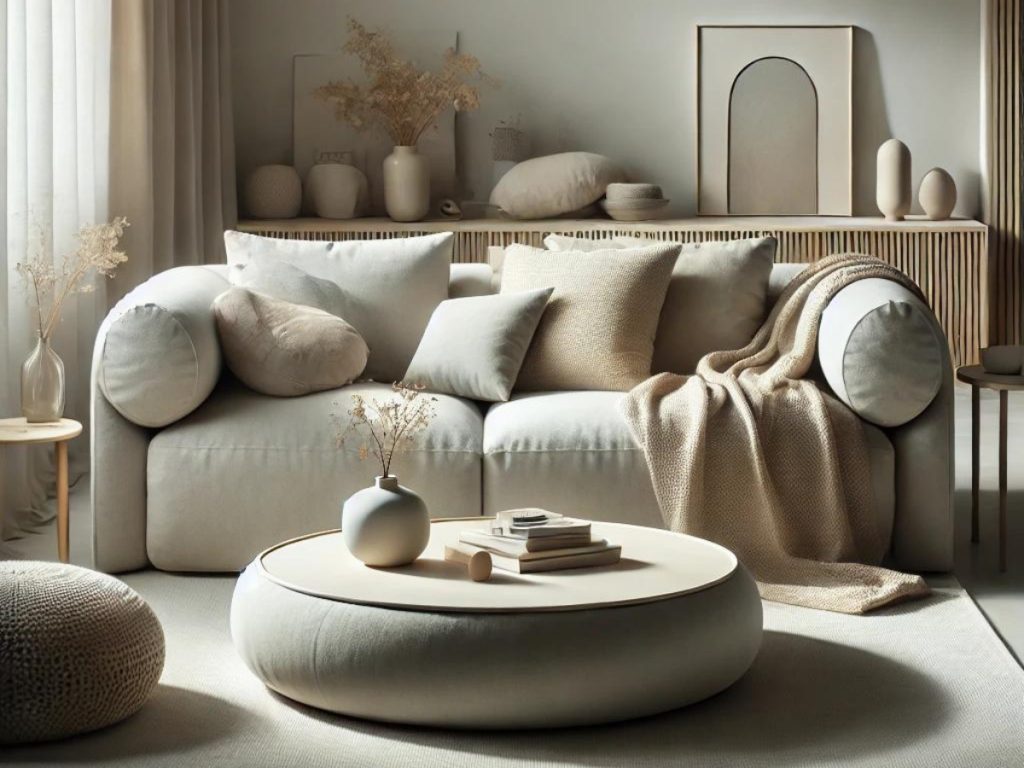
The rise of soft organic shapes continues through this year. Curved furniture and rounded architectural details soften interiors. Arched doorways, round mirrors, and circular coffee tables are just a few examples of how this trend is manifesting.
Replace angular furniture with curved alternatives, such as a round dining table or a soft-edged sofa. Add architectural interest with arched entryways or rounded shelving units for a softer ambience and more cohesive space.
Japandi
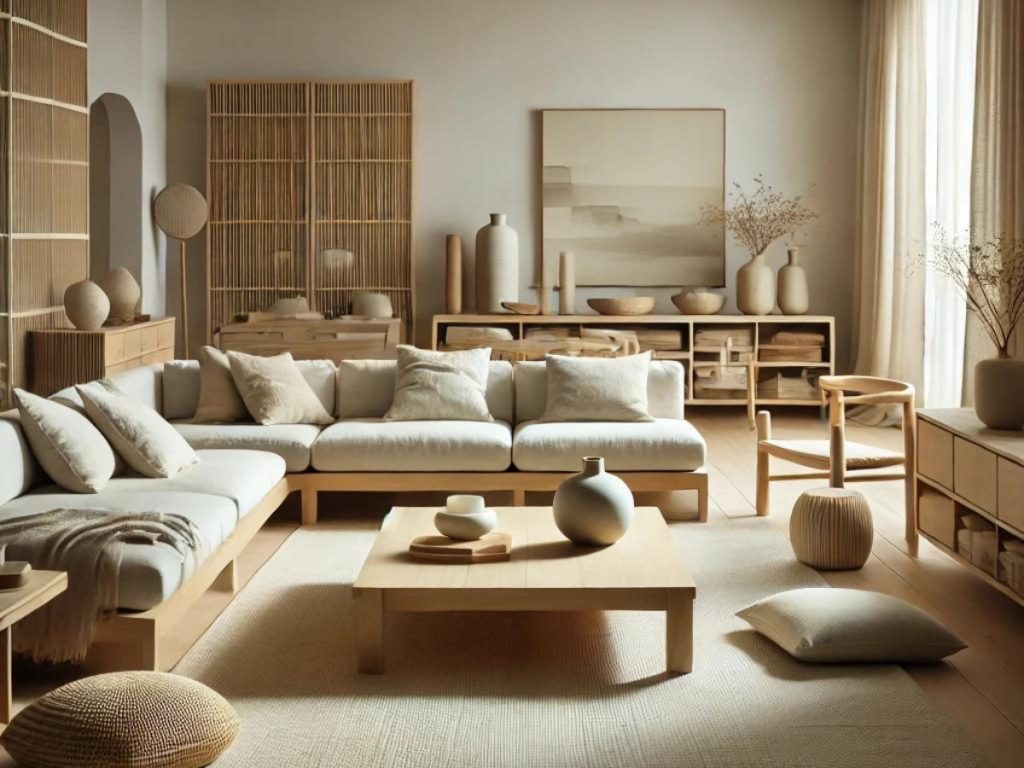
The Japandi style is blend of Japanese minimalism and Scandinavian warmth, and remains strong throughout 2024, but takes on a cosier tone as the year progresses. Clean lines and functional design are still present, but there’s a focus on creating an inviting, lived-in space. Warmer woods, textured textiles, and hand-crafted ceramics take centre stage.
Keep your space uncluttered, but incorporate cosy elements like woollen rugs, woven baskets, and handcrafted pottery. Consider furniture in lighter woods like ash or birch paired with neutral-toned, soft textiles.
Artistic Lighting
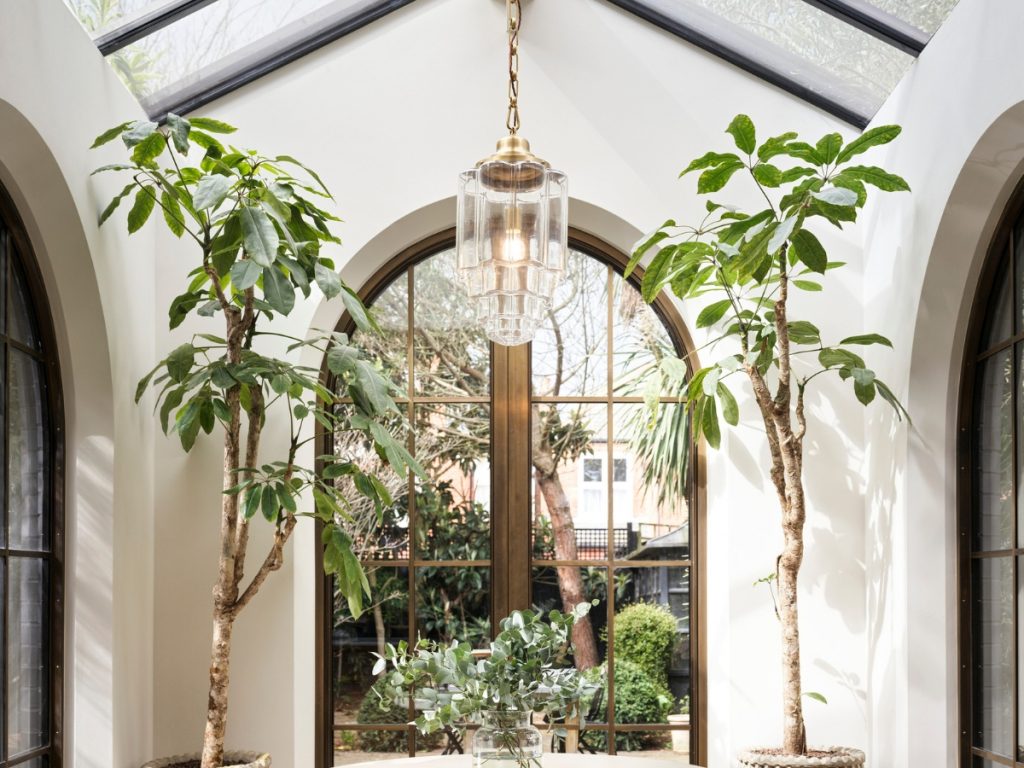
Lighting is becoming more than just a functional element—it's turning into a central design feature in its own right. This Autumn sees oversized and sculptural lighting fixtures in brass and matte black are gaining popularity. These pieces are clean and bold, making a statement as well as bringing elegant light to the room.
Look for wall lights with unique shapes or oversized floor lamps that double as art pieces. A large statement pendant over a dining table or in a living room can dramatically transform the ambience.
Rich Kitchens and Bathrooms
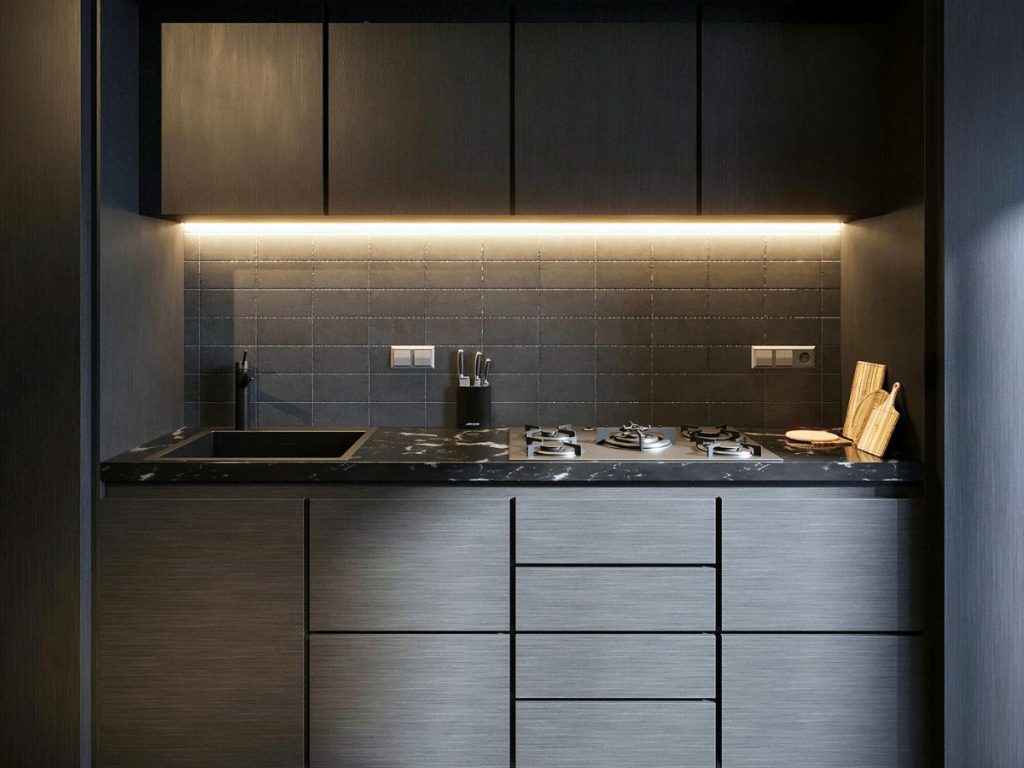
While bright kitchens have reigned for years, autumn 2024 shifts towards a more dramatic space. Dark cabinetry, stone countertops, and rich metallic finishes are taking over kitchens and bathrooms. Deep navy, charcoal, and forest green are key colours, creating a luxurious yet cosy vibe.
Choose matte black or deep green cabinetry, paired with gold or brass hardware for a touch of luxury. In bathrooms, try rich, dark tilework or a bold, statement vanity in a deep hue.
Biophilic Living

Incorporating natural elements to enhance well-being remains a top trend throughout the year, and Autumn is no different. Large indoor plants, natural light, and organic materials create a calming environment that helps you to connect with nature from the comfort of your home.
Introduce a variety of plants to your space, from towering kentia palms to a hanging golden pothos. Maximize natural light by using sheer curtains and bring in natural materials like jute pot covers and wooden plant stands.
Personalised, Vintage Accents
This autumn, it’s all about personalization and storytelling in design. Vintage and heirloom pieces are making a comeback, with many opting for unique, one-of-a-kind decor items that tell a personal story. Mixing vintage pieces with modern design creates an eclectic, timeless feel.
Visit local antique shops to find unique furniture and accessories. Pair a vintage rug with modern furniture or mix a mid-century coffee table with contemporary accents.
Autumn 2024 interior design trends are all about creating spaces that feel warm, welcoming, and personal. By blending natural materials with modern touches, and embracing cosy textures, you can easily transition your home into a stylish, seasonal sanctuary. Whether you're drawn to moody hues, organic shapes, or statement lighting, this Autumns trends offer plenty of inspiration to make your space feel fresh and comforting as the season changes.
This blend of cosy textures, rich colour palettes, and natural materials ensures that autumn 2024 will be a season for interiors that combine beauty with comfort and sustainability. What’s your favourite trend for fall this year?
[related_products is_auto_added="1"]As the golden hues of autumn settle in, the design world embraces the warm, comforting, and sophisticated tones that define the season. This year, autumn interior design trends are all about blending comfort with modern elegance, drawing inspiration from nature in fresh, creative ways. Whether you’re looking to refresh your space or embark on a […]

Zigbee is a wireless communication protocol designed for low-power, low-data-rate applications, primarily in the realm of home automation, smart devices, and industrial control systems. Here's a quick overview of what Zigbee is and why it matters.
Key Features of Zigbee
Low Power Consumption
Zigbee is engineered to consume minimal power, making it ideal for battery-operated devices like sensors, lights, and thermostats. Devices can run for months or even years on a single battery.
Mesh Networking
One of Zigbee's standout features is its ability to create mesh networks. In a mesh network, devices can communicate directly with each other, without the need for a central hub or router. This not only extends the range of the network but also enhances its reliability—if one device fails, the network can re-route communications through other devices.
Scalability
Zigbee networks are highly scalable, capable of supporting up to 65,000 devices on a single network. This makes it a robust choice for both small-scale home automation setups and large industrial systems.
Cross Compatibility
Zigbee is based on the IEEE 802.15.4 standard and is designed to work across different manufacturers and devices. This means you can mix and match devices from different brands, as long as they all support Zigbee.
Secure and Reliable
Zigbee offers built-in security features, including encryption, to protect data and ensure secure communication between devices. It’s also known for its reliability in transmitting data even in environments with a lot of wireless interference.
Common Uses of Zigbee
Smart Home Devices: Zigbee is widely used in smart home devices like smart lights, smart switches, door locks, thermostats, bulbs, and sensors. For example, a Zigbee-enabled thermostat can communicate with a Zigbee light bulb to dim the lights when you lower the temperature.
Industrial Automation
In industrial settings, Zigbee is used for monitoring and controlling machinery, environmental conditions, and energy usage. Its mesh networking capability is particularly useful in large industrial facilities.
Health Care
Zigbee is also used in medical devices for monitoring patient vitals and ensuring seamless communication between different medical equipment.
Why Choose Zigbee?
Zigbee is a popular choice for many IoT (Internet of Things) applications because it strikes a balance between power consumption, range, and data throughput. It’s not as fast as Wi-Fi or as long-range as some other protocols like LoRaWAN, but its low power requirements and robust mesh networking capabilities make it an ideal solution for smart homes and other applications where devices need to work together seamlessly over time without frequent battery changes.
In summary, Zigbee is a versatile, energy-efficient wireless protocol that has become a cornerstone of modern smart home and industrial automation systems. Its ability to create large, secure, and reliable networks with minimal power usage makes it a go-to choice for many manufacturers and users alike.
[related_products is_auto_added="1"]Zigbee is a wireless communication protocol designed for low-power, low-data-rate applications, primarily in the realm of home automation, smart devices, and industrial control systems. Here’s a quick overview of what Zigbee is and why it matters. Key Features of Zigbee Low Power Consumption Zigbee is engineered to consume minimal power, making it ideal for battery-operated […]
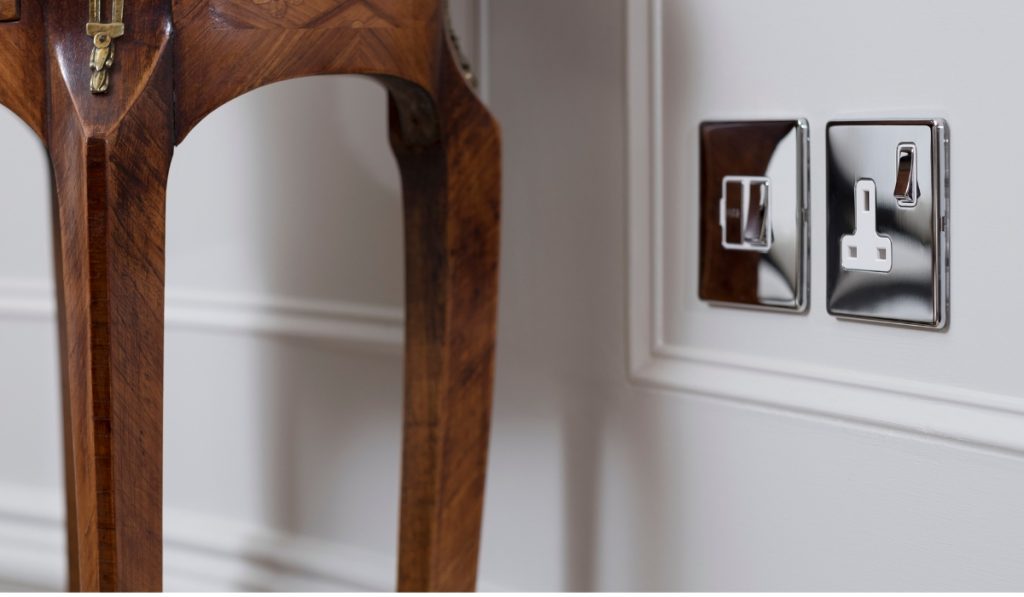
An isolation switch is a crucial electrical safety device designed to disconnect a part of an electrical circuit from the main power supply, ensuring that the circuit can be safely worked on without any risk of electric shock. Isolation switches are often used in both residential and industrial settings to protect equipment and personnel. They provide a clear, visible means of cutting off electricity to specific circuits or devices, making maintenance, repairs, and emergency shutdowns safer and more straightforward.
Types of Isolation Switches
Isolation switches come in various types, each tailored for specific applications. Below are some of the most common types:
Fused Isolation Switches
Fused Isolator Switches or FCUs combine the function of a fuse and an isolator in one unit. The fuse provides protection by breaking the circuit if an overcurrent occurs, while the isolation function allows the circuit to be safely disconnected. Typically used in industrial settings where high-power equipment is involved, such as large machinery or HVAC systems.
Double Pole Isolation Switches
Double Pole Isolation Switches disconnect both the live and neutral wires, ensuring that the entire circuit is completely isolated from the power supply. Commonly used in domestic installations, particularly for isolating appliances like cookers or water heaters. They provide a higher level of safety compared to single-pole switches.
Rotary Isolator Switches
Operated by turning a handle, rotary isolators are often used for high-current applications. They are available in different configurations, including single-pole, double-pole, and multi-pole versions. Widely used in commercial and industrial environments to isolate machinery or specific sections of an electrical system.
Key Operated Isolation Switches
These switches can only be operated using a key, providing an extra level of security to prevent unauthorized access. They ensure that only authorized personnel can disconnect or reconnect the circuit.
Used in areas where strict control over electrical isolation is required, such as in factories or high-security environments.
Main Isolator Switches (Mains)
This is the primary isolation switch for a building or installation, typically found in an electrical box inside the home, or ‘the mains’. It disconnects the entire electrical supply to a property. Essential for safely performing maintenance or electrical work on a building’s wiring. It is usually operated during major electrical work or in emergencies.
Isolation switches are fundamental components in ensuring electrical safety, providing a reliable means to disconnect circuits from the power supply. Understanding the different types and their applications helps ensure that the right switch is used for the right job, enhancing both safety and efficiency in electrical installations.
[related_products is_auto_added="1"]An isolation switch is a crucial electrical safety device designed to disconnect a part of an electrical circuit from the main power supply, ensuring that the circuit can be safely worked on without any risk of electric shock. Isolation switches are often used in both residential and industrial settings to protect equipment and personnel. They […]
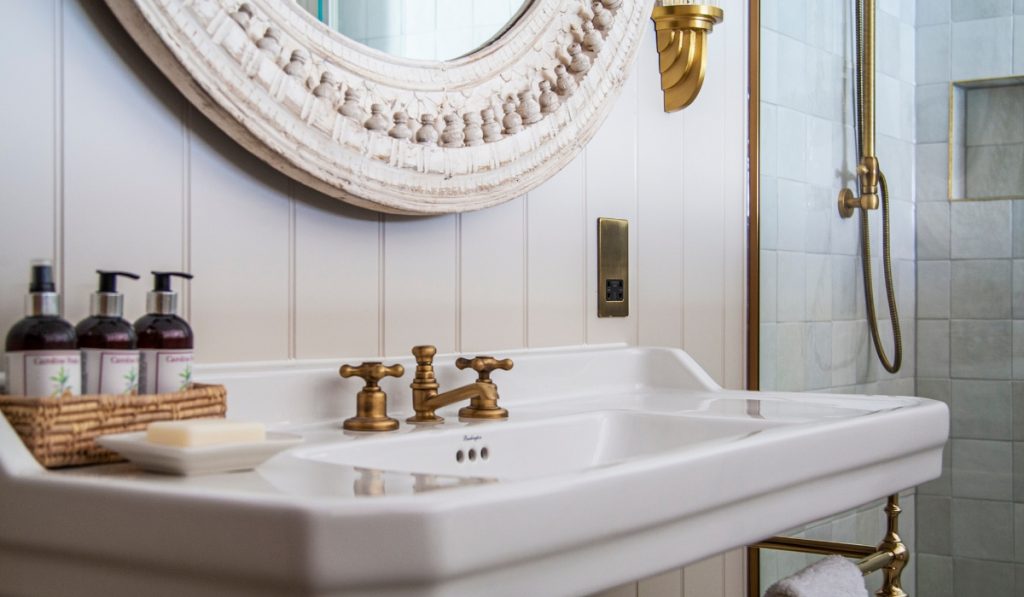
One of our most popular ranges here at Elesi is our ranges of sockets and switches, and with so many different finishes to choose from it can be a little daunting to narrow down which is the right finish for your home. A well planned interior design benefits from sockets and switches that will complement your chosen décor. In this guide we will explore each finish in detail so that you make an informed decision about which finish will complete your look.
Brushed Brass
Brushed Brass gives a wonderfully rich gold tone that pairs beautifully with gold accents and details within your interior design. Furthermore, you can choose a black or white switch-plate insert, depending on the complementing tones of your accent metal. For example, the black insert pairs well with darker tones, while white inserts work beautifully with neutral.
Antique Brass
With a brushed detailing, Antique Brass combines the warmth of aged brass, and the modern brushed surface to create a timeless switch plate that suits a traditional or classic interior. This subtle finish is not only elegant, but the brushed surface is perfect for high traffic areas, as this will effectively hide fingerprint marks.
Old Brass
With its rich honeyed tones, Old Brass is a beautiful finish designed for period properties, country cottages, and rustic spaces. Each piece is unique with a purposefully aged appearance, and pairs well with darker woods, neutral tones, and stone flooring to complement the authenticity of a period interior.
Vintage Brass
Vintage Brass has a much deeper and worn appearance than its richer counterpart, Old Brass. Much darker in tone, this delightfully rich finish has the look and feel of weathered brass, perfect for an historic property that would benefit from authentically aged brass accents.
Bronze and Antique Brass
A powder-coated matt finish with a rich bronze tone that comes with Antique Brass switches. Bronze is another finish that works beautifully with period properties and country homes, while the Antique Brass switches bring an understated elegance to this rustic design.
Bronze and Brushed Brass
For a bolder switch plate, pairing Bronze with Brushed Brass switches brings a brighter gleam that is more eye-catching than its Antique Brass counterpart. Perfect for traditional interiors with gold décor or accent metals.
Copper
With a distinct pinkish hue, Copper is a beautiful metal to pair with copper kitchenware or even rose gold décor. This unique finish works beautifully in country homes, rustic kitchens, or as part of a Scandi space, bringing a warm depth to a neutral interior.
Brushed Chrome
Brushed Chrome is a brilliantly versatile, cool toned metal that works well in many modern interiors. The brushed surface hides fingerprints effectively, making this a great option for high traffic areas, as well as adding a touch of style throughout the home.
Brushed Chrome and Brushed Brass
Pairs the Brushed Chrome plate with a Brushed Brass switch gives an elegant twist on this classic finish. Mixed metals are a great way to add depth and dimension to your space, especially if your interior contains golds and silvers throughout. This finish is both elegant and eyecatching.
Polished Chrome
This classic metal is a versatile and adaptable finish that works in a variety of interior design. Working equally well with an Art Deco space, as part of a monochrome or minimalist space, or to complement vintage décor, the cool, mirror finish is a brilliant way to liven up the room, and is available with black or white inserts, depending on your colour palette.
Black Nickel
Similar to Polished Chrome, Black Nickel has the same mirror finish and modern qualities as its brighter counterpart, with a warmer and richer colour. This darker toned metal makes the perfect finish for modern and contemporary spaces with a deeper colour palette, particularly dark woods or grey hues.
Matt Black
Matt Black is a versatile finish that suits almost any modern interior design. On its own, this adaptable finish pairs beautifully with monochrome, neutral, and jewel-tone palettes alike, and is perfect for a property with several interior styles throughout the home.
Matt Black and Brushed Brass
Combining smooth Matt Black with the bright gold tone of the Brushed Brass finish is a gorgeous contrast of textures and colours that pairs particularly well with warm neutral and jewel-toned interiors. The gold accent matches with gold décor in the space, bringing the interior together beautifully, a great addition to Art Deco spaces.
Matt Black and Antique Brass
For a more subtle alternative, pairing Antique Brass with Matt Black allows this versatile finish to work in more traditional spaces. The softer tone of the Antique Brass is a little more understated than it’s brighter Brushed Brass counterpart, making it a great addition to a renovated period property or townhouse.
White Metal
With a slim-line profile and matt surface, this White Metal flat plate offers a clean and minimalist design with a screwless finish. This design is particularly effective in minimalist or contemporary kitchens, or for areas that would benefit from an understated design that blends seamlessly with white interiors.
White Metal and Polished Chrome
Adding the Polished Chrome accent brings a fresh dimension to the understated White Metal finish. Polished chrome is an inherently modern metal, particularly paired with white. This finish works best in a modern or minimalist interior that has Polished Chrome accents such as door handles, taps, or decorations. Great for kitchens and bathrooms.
Silk White - Lieber
The White Silk range from Lieber is the perfect way to add sockets and switches to a space that doesn’t benefit from designer plates, such as a garages or utility rooms. Lieber also carry a range of Black Nickel, Copper, and Polished Chrome that come with your choice of black or white inserts, which are a perfect budget-friendly way to add some style to your interior.
Paintable Collection
The Paintable Collection is a customisable range of pre-primed plates that allow you to match your sockets and switches with your chosen wall colour for a seamless appearance. These primed plates can be painted to blend to your wall colour, while the metal switch complements your interior design. This is a great option statement walls, so as not to detract from your décor. This plate is available with a Brushed Brass, Antique Brass, and Brushed Chrome switch on all switchable plates to give a unique dimension to your space.
We hope that this guide has helped you to compare your choices and narrow down the right finish for your project. All of our finishes include a fully comprehensive selection of sockets and switches, including kitchen switches, USB sockets, Euro Modules, and even customisable plates so that you can design the perfect combination for your needs. Feel free to reach out to our friendly customer service team if you need any further help with choosing your sockets and switches.
[related_products is_auto_added="1"]One of our most popular ranges here at Elesi is our ranges of sockets and switches, and with so many different finishes to choose from it can be a little daunting to narrow down which is the right finish for your home. A well planned interior design benefits from sockets and switches that will complement […]
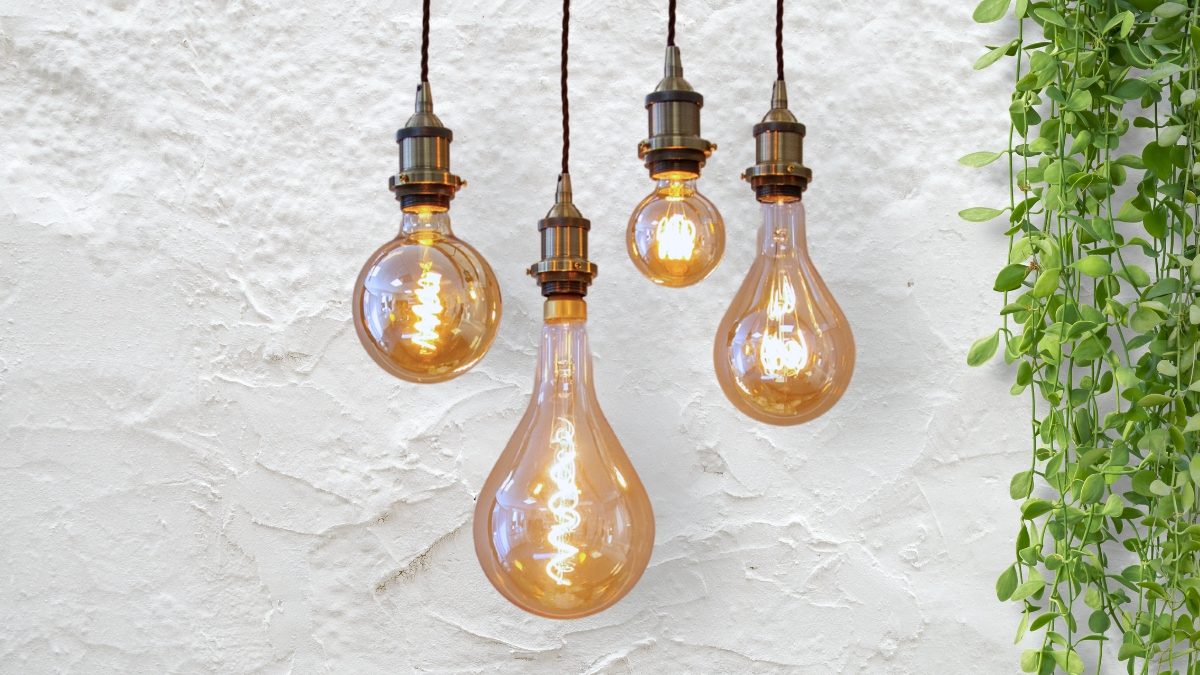
Choosing the right bulb for your needs can be overwhelming given the variety of options available. With so many choices from different fittings, colour temperatures, dimming capabilities, smart technology, and light levels, getting the right bulb for your space can seem daunting. In this guide, we will walk you through the key information that will help you to determine which is the right bulb for your purposes.
First, we will outline the three types of bulbs available. With the ban on the sale of new Halogen and Incandescent bulbs in the United Kingdom as of 2021, it is more than likely that you will be using LED bulbs, but it’s still worth knowing the differences.
Types of Bulbs
Incandescent Bulbs - These are the traditional bulbs that most people are familiar with. They produce light by heating a filament inside the bulb. There are many reasons why people prefer incandescent lighting, and their consistent, natural warm light is one of them. The other is that incandescent bulbs are relatively cheap. The problem with this low up-front cost is the subsequent electricity bills that mirror the inefficiency of these bulbs. Incandescent bulbs lose a lot of their energy through heat as a by-product to the light. Not only is this costly in the long run, but because of the heat generated, they have a relatively short lifespan, meaning more bulbs replaced over time.
Halogen Bulbs - Another type of incandescent bulb, the halogen bulbs use halogen gas to increase light output. These are typically much brighter than traditional incandescent bulbs, have a longer lifespan, and are a little more energy efficient, though nowhere near as efficient as LED bulbs.
LED Bulbs - Light Emitting Diode (LED) bulbs are highly efficient and long-lasting. They don’t require gasses to operate and generate very minimal heat, making them extremely energy efficient. They’re also available in a multitude of colour temperatures, including RGB colours to create any ambience or colour scheme you need for a lighting project. The only downside to an LED bulb is their higher upfront cost. This, however, is offset by energy savings over time, and is worth the investment, especially considering their longer lifespan than an incandescent or halogen bulb.
Smart Bulbs - While technically still an LED bulb, a smart bulb has the added benefit of smart technology built into it. This means you can control your light wirelessly via your phone for ultimate convenience. These still have all of the benefits of an LED bulb.
Bulb Fittings and Caps

Bulb fittings, also known as caps or bases, are the part of the bulb that connects to the power supply. Each type of bulb has a letter followed by a number. The letter denotes the type of fitting, while the number represents the size of the fitting in millimetres. For example, B22 represents a 22mm Bayonet fitting. This helps you to understand the precise size you may need for your fixture.
E14 - Small Edison Screw (SES): small size for lamps and smaller fixtures.
E27 - Edison Screw (ES): The larger and more common size for ceiling, floor lights, large table lamps, and wall lights.
B15 - Small Bayonet Cap (SBC): Used for small wall fittings and table lamps.
B22 – Bayonet Cap (BC): Widely used in the UK and other countries.
GU10 - Common in spotlights and downlights, especially in kitchens and bathrooms.
G4, G9 and GU5.3 - These have small pins, designed for cooker hoods, or as smaller decorative or accent lighting.
Lumens
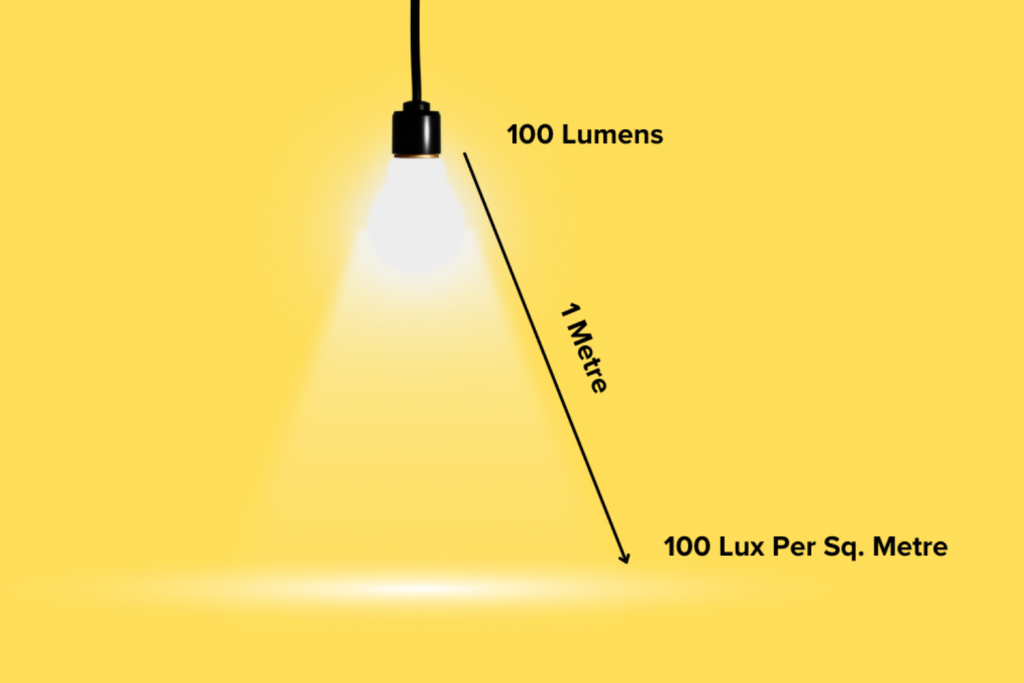
Lumens represents the brightness in a bulb, while Lux measures the amount of light that falls onto a surface. The higher the lumens, the higher the brightness in the bulb. The brightness you require for your room depends on many factors, such as the size of the space, the purpose, and the amount of natural light the room already has. A kitchen will require much more light than a bedroom, so take this into consideration when deciding on how many lumens you choose.
To learn more about lumens and lux, visit our blog, 'What is Lux Level?'
Dimming Functions
Not all bulbs are created equal, and that counts for dimming as well. You can often find bulbs marketed as dimmable or non-dimmable bulbs, and dimming an LED is not quite as straight forward as simply reducing the power to the bulb.
Typically, the most common operation for LEDs is Pulse Width Modulation (PWM). This works by switching the LED on and off rapidly enough that the human eye perceives a steady light. When adjusting the brightness on this type of LED, the ratio of on-time to the off-time is adjusted within each cycle. In simple terms, at 10% brightness, the LED is only on for 10% of the cycle, and off for the other 90%. Turning up the brightness to 50%, the ratio would change, and the LED would be on for 50% and off for the other 50%.
Without dimming capabilities, the LED bulb is unable to maintain this cycle and results in strong flickering, or the bulb failing entirely. To avoid this, ensure that your bulbs are fit for dimming before pairing with a dimmer switch.
Dim to Warm is a clever feature that’s only possible with LEDs. Using a regular dimmer switch, you can adjust the colour temperature of your light, as opposed to adjusting the brightness. This allows you to seamlessly move between different colour temperatures without the need for more than one light.
Colour Temperature
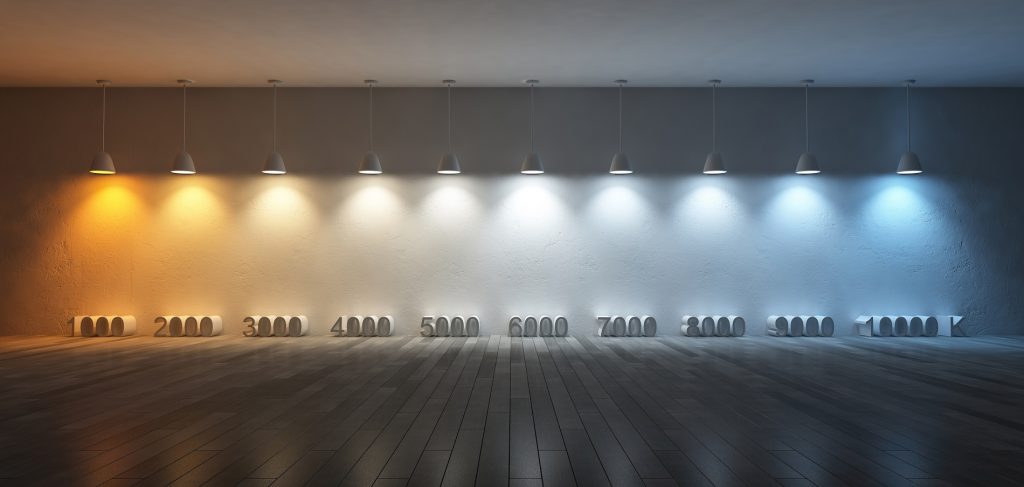
Colour temperature plays an important part in the function of your space. Temperatures range from 1000k for the warmest tone of light with more orange right up to 10,000k for a cool blue. Typical bulb levels will range between 1500k and 5000k. Visit our blog ‘What is Colour Temperature’ to learn more.
Warm temperature light is typically used for ambience, while cooler toned light is best for workspaces and for illuminating work surfaces. Using a cool toned light in a reading nook will not lend to a relaxing atmosphere. Similarly, a warm tone may not allow you to see as well in a workspace.
It can also shift the appearance of colours in the room. Paint colour may appear a lighter or darker in shade. It may even appear a different colour entirely depending on the temperature of the light. The cooler a light gets, the bluer the tone, whereas orange is the base for warmer colour temperatures. It’s important to bear this in mind when choosing colours in your interior design.
CRI

Similarly to colour temperature, CRI or Colour Rendering Index, refers to the way that light emitted reflects colour back. A lower CRI bulb can leech colours, and affect the way that you view that colour, whereas a high CRI bulb will allow those colours to be reflected back to the eye as true as with sunlight.
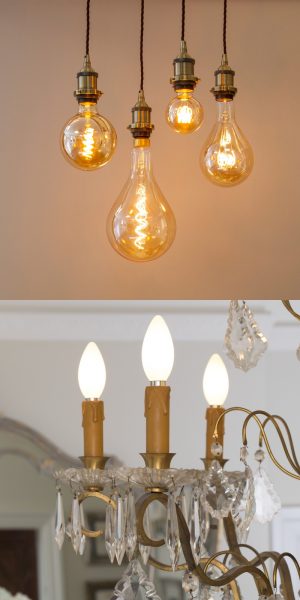
Opal VS Filament
The style of bulb you choose for your light fitting primarily depends on the design of your fitting, though the opacity of the glass has an impact on the kind of light it emits as well.
Vintage style filament bulbs pair perfectly with a decorative glass pendant or bulb holder. The bulb adds a decorative element to the fitting which perfect for vintage or industrial interiors. There are also larger statement bulbs that are perfect for stand-alone fittings or as part of a larger lighting design, making the bulb itself the centre of the display.
Opal glass bulbs are perfect for enclosed shades or pendants where the light can be diffused evenly around within the fitting. The same can be said for open fittings for a more evenly diffused light around the entire room.
Considerations for Choosing the Right Bulb
Choosing the right bulb involves balancing brightness, colour temperature, and function. Determining the primary use of the bulb is the best place to start. Do you need cooler, brighter task light for your kitchen, or do you need warmer, softer light to relax in your bedroom? Choosing a dimmable bulb, or even a smart bulb gives you the choice for rooms where you might need to adjust your lighting, not to mention typically being more energy saving. Ensure that you have chosen the right bulb cap to fit the light fitting, and that the bulb itself can fit inside your chosen light fitting. Once you have answered all of these questions, you will have a clear understanding of the type of bulb you will need for your space.
[related_products is_auto_added="1"]Choosing the right bulb for your needs can be overwhelming given the variety of options available. With so many choices from different fittings, colour temperatures, dimming capabilities, smart technology, and light levels, getting the right bulb for your space can seem daunting. In this guide, we will walk you through the key information that will […]
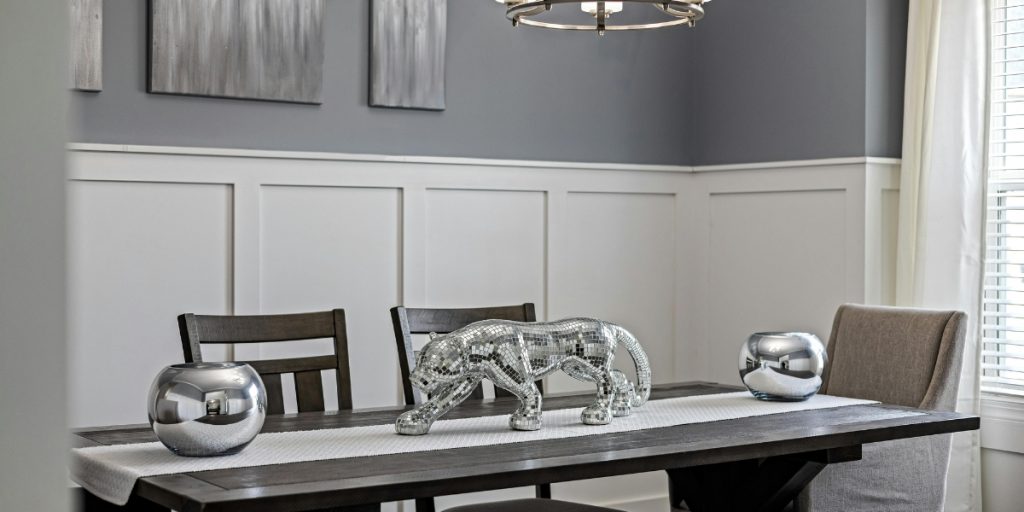
Whether you’re incorporating silver hardware, decorating your walls with silver highlights, or adding silver furnishings to your space, choosing the right colour palette can help to balance this beautiful finish. In this guide, we will explore a variety of colours that complement and harmonise with silver to create a cohesive interior design.
Neutrals Tones
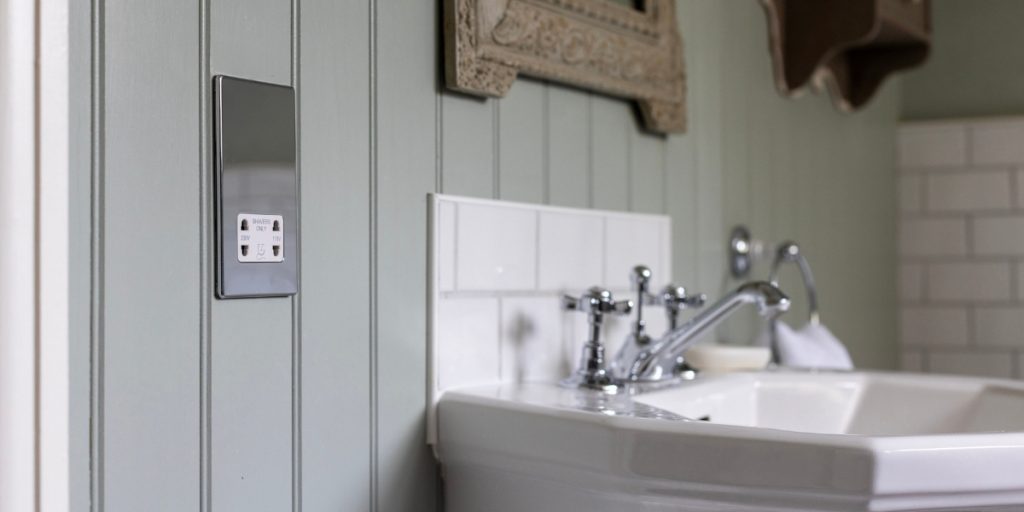
Pairing neutrals with silver creates a harmonious atmosphere, perfectly suited for a contemporary or minimalist interior. Silver enhances monochrome interiors by breaking up matte textures and invigorating a potentially monotone or drab décor.
Crisp white walls or furnishings accentuate the reflective qualities of silver, and enhances brightness, particularly in smaller spaces. Soft beige provides a neutral backdrop for silver accents, creating a sense of warmth and understated elegance. Similarly, light greys right through to darker stony greys benefit from this gleaming finish. The warm undertone in taupe provides a subtle contrast to the cool tone of silver. This adds depth and dimension to your design scheme.
Bold Hues
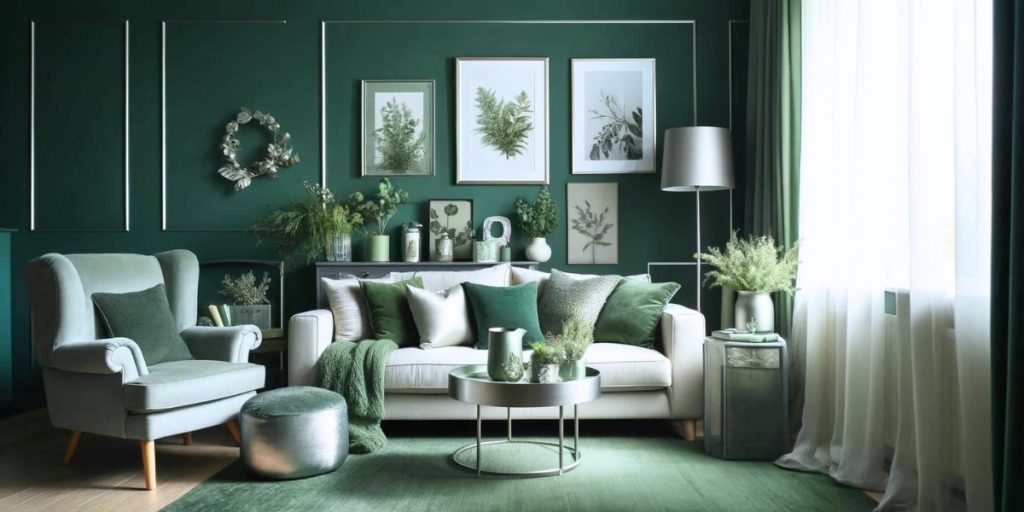
Rich blues such as navy and midnight blue create a striking contrast when paired with silver, adding depth to your space while maintaining a sense of opulence and refinement.
This effect is also achieved with teals, forest greens, and even rich reds such as burgundy and maroon, offering a warm backdrop to really emphasise the gleaming cool tones of silver. Sage green offers a lighter and more refreshing contrast to silver that brings a natural, earthy richness to your indoor space.
Tranquil Pastels
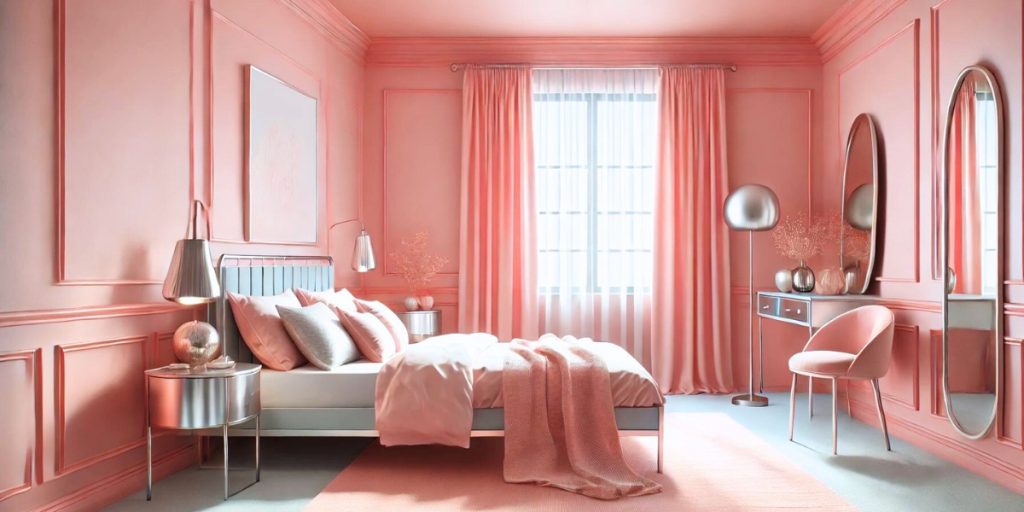
Pastels create a serene and calming ambience, and this pairs with beautifully with silver accents such as light fittings or ornamentation. Delicate shades of lavender, power pinks, and pale blue hues evoke a sense tranquillity, and creates a soft and inviting atmosphere when combined with silver furnishings
Mixing Metals
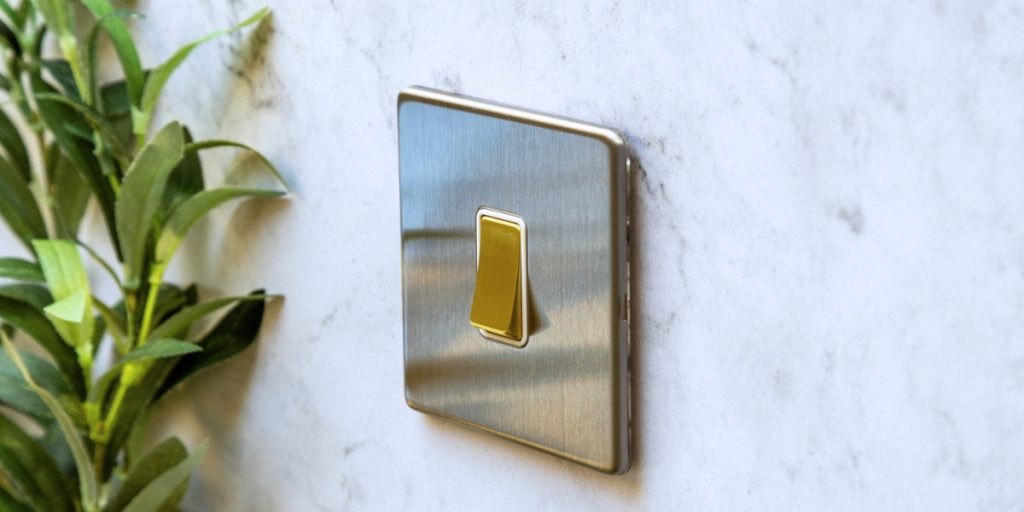
Pairing silver with warmer metals such as gold, copper, bronze, or brass adds a new dimension to the way you enhance your space. The play of warm and cool toned metals lends a new dynamic to your interior, infusing the space with warmth, and creating visual interest in your décor.
Silver is a versatile and forgiving metal that complements and enhances many colours with ease. With silver ornaments, furnishings, wallpaper, or even hardware, you can create a space that exudes style, sophistication, and charm. Whether you prefer earthy neutrals, bold jewel tones, or serene pastels, the possibilities for designing with silver are endless.
[related_products is_auto_added="1"]Whether you’re incorporating silver hardware, decorating your walls with silver highlights, or adding silver furnishings to your space, choosing the right colour palette can help to balance this beautiful finish. In this guide, we will explore a variety of colours that complement and harmonise with silver to create a cohesive interior design. Neutrals Tones Pairing […]
